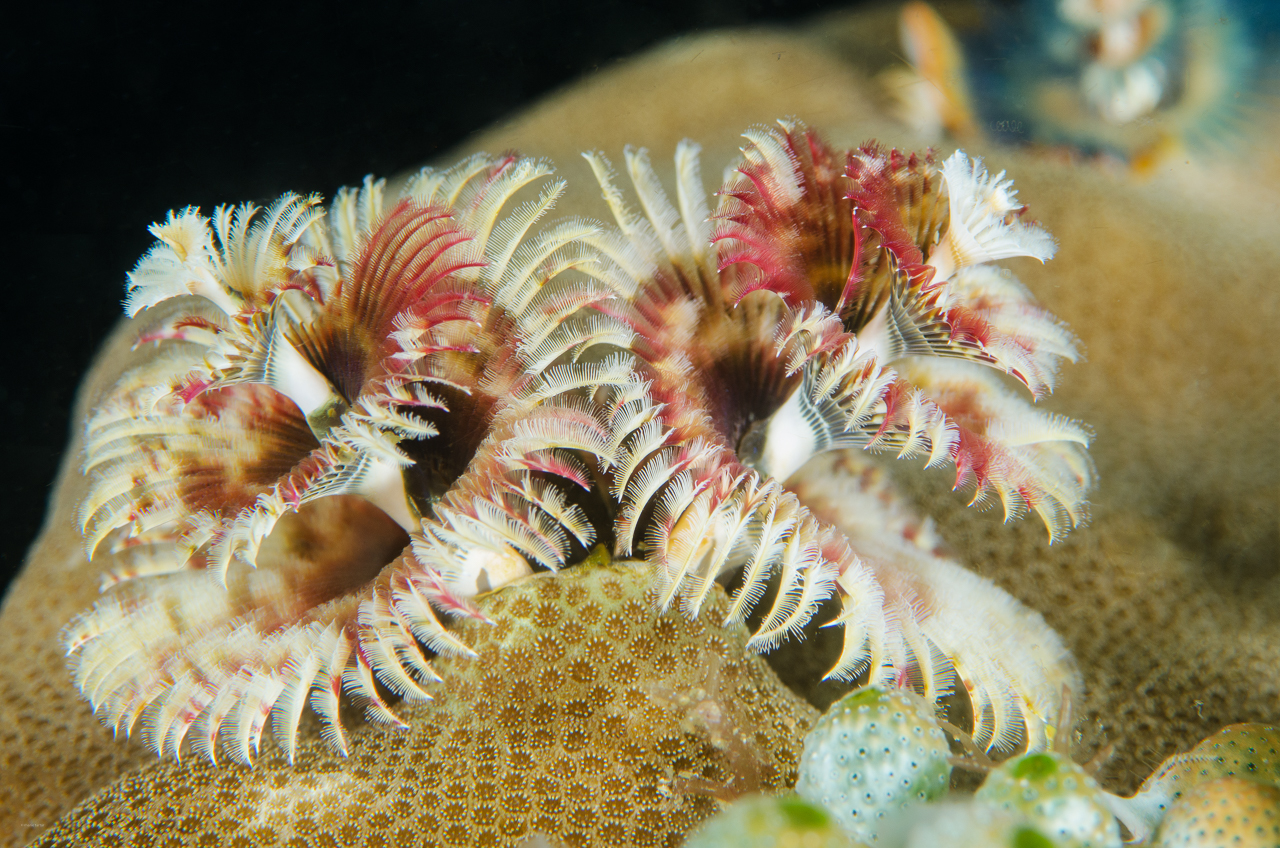
After a beyond-my-wildest-dreams week luxuriating in Kyoto during an off-the charts cherry blossom bloom, we met up with our friend Martin at Narita airport to fly to Manila. Diving in the Philippines was Part 1 of a 2-part experiment this year for us: trying to find a diving destination we like as well as Indonesia, accessible with a non-stop flight from LAX. Part 2 would be Fiji, in the fall. For Martin, this would be a non-shark birthday trip. We’d meet up with Greg in the Philippines.
In Manila, we had booked a room at the Manila Marriott near the airport, where the dive group would be collected the following morning. Martin had found a less expensive alternative at a newer, next door hotel with equivalent ratings, the Belmont. It had a free shuttle so we headed outside together, figuring we would hitch a ride there.
While there was a complementary shuttle, we learned this “airport hotel” was 20 minutes away, and the next shuttle would be back in 50 minutes! The Manila airport is odd-the domestic and international terminals are quite far apart and not connected by a shuttle and not within walking distance of each other.
A cab for the 3 of us to the Marriott and the Belmont would be $23-sold! It was 11 pm already and it had been a long travel day for us and an even longer one for Martin, who had flown that day from San Diego.
We saw the magenta hued neon lighting up the Belmont as we were deposited at the Marriott. We stored our dive gear and Martin’s downstairs and headed to reception. That was when it got weird.
At first nothing seemed amiss. Our passports were photocopied, we filled out our address card and even had a room number. Then the manager emerged and sidled up to us, saying in a low voice that they had “a situation” at the hotel and they were overbooked and didn’t have a room for us. But, not to worry, we had been rebooked at the next door Belmont, and transportation arranged.
What could we do but get in the waiting car? Martin was still standing at the front desk of the Belmont, where initially they had been unable to locate his reservation. At midnight, we were all finally installed in our rooms for a much needed rest.
Saturday, April 9, 2016
Our transfer to Anilao in the Batangas area by bus was purported to be 2.5-3 hours, but construction on the road and snail’s pace, barely crawling traffic made it closer to 4.5-5 hours.
Facebook made me aware that our friend Bob was busy diving in the very area we were headed. We chatted via FB messenger, discovering that he was staying within walking distance. He came over in the evening, his last in the area, finding his way to our resort’s bar before we had even discovered it for ourselves!
It was very apropos to see Bob on the cusp of our discovering the Philippine capital of muck diving, as years ago, our first trip to Indonesia’s capitol of muck, Lembeh Strait, was with Bob, his wife Debbie, and our mutual friends Nancy and Gerry.
Muck diving is the antithesis, at least at first glance, to technicolor coral reefs. Generally, this term refers to sandy and silty slopes off volcanic islands, with an unpromising, rather bland appearance. At least until you start to look really closely. Hidden in little patches of algae, in rubble, in rotting logs, in waste both organic and manmade, is a hidden world of unique creatures.
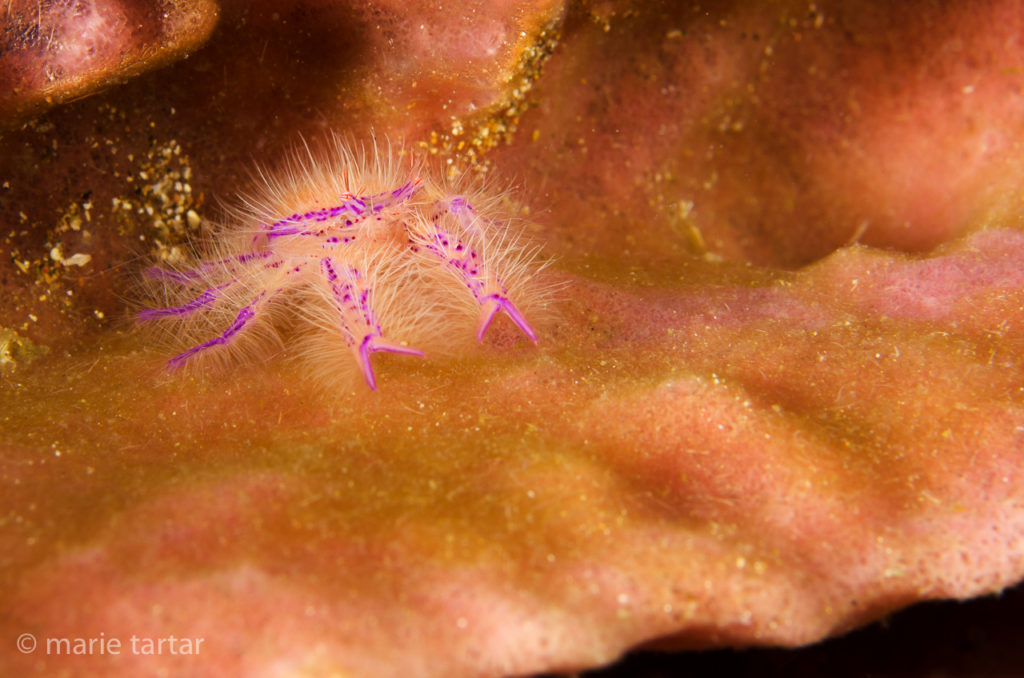
An Anilao dive guide special: Squat lobsters (Lauriea siagiani) live on a characteristic barrel sponge; despite knowing their predilection for secreting themselves in recesses of a very recognizable giant barrel sponge (Xestospongia testudinaria) , I’ve never had much luck finding one on my own.
Some creatures are near microscopic and require intimate knowledge of their preferred substrate and distribution.
This environment seems to serve as a nursery for juvenile, miniature versions of animals found in coral reefs, such as frogfish and scorpionfish.
The diving itself is both easy and difficult. It is easy in the way finding sense. Generally, the boat anchors in the shallows, and a typical dive profile zigzags downslope and back again. The visibility can vary considerably, and limited visibility is commonly encountered, making it easy to be separated from your guide or group and miss out on seeing a rare find.
The hardest part of diving in muck is the water is easily clouded, so it is completely counterproductive to kick anywhere close to the sand.
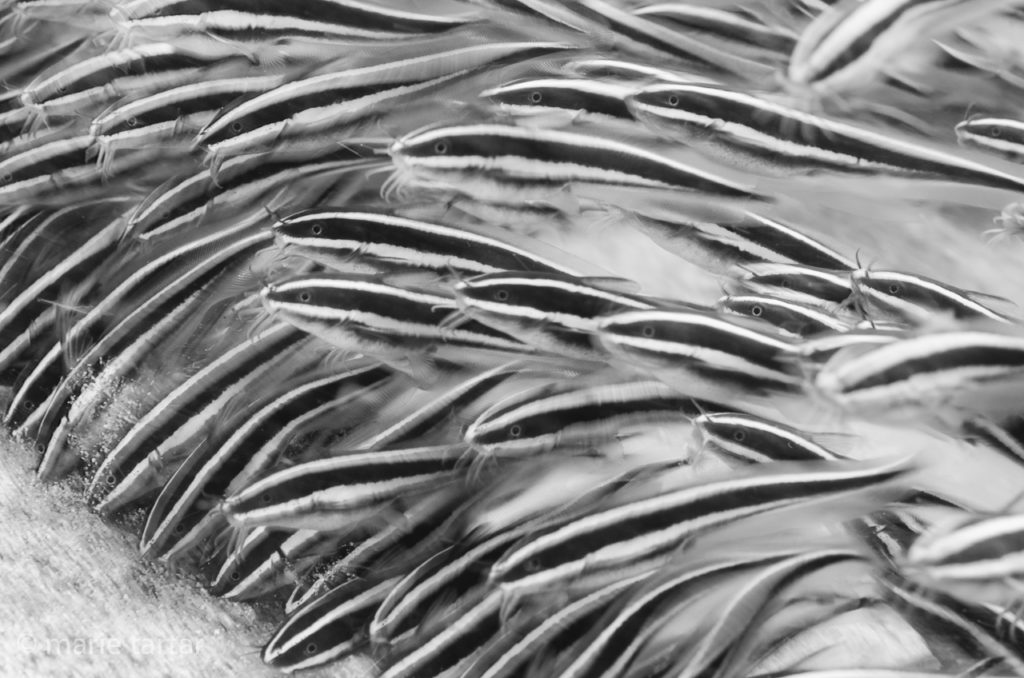
A herd of maraudering miniature striped catfish ((Plotosus lineatus)) ruffles the sand, rooting out morsels, but it’s not OK for a diver to raise a cloud of sand with their fins!
Even when the guide summons one with a rattler or flashing a light, it is hard to swim quickly toward them. It is necessary to rise well above the sand before even thinking about finning. The alternate kick, frogleg style (legs bent at the knees and moving the feet only), is tough to do quickly. Sometimes, the current works to keep the particles in the water column away from your subject. At other times, the current spins you around so that it is hard to maintain your desired position.
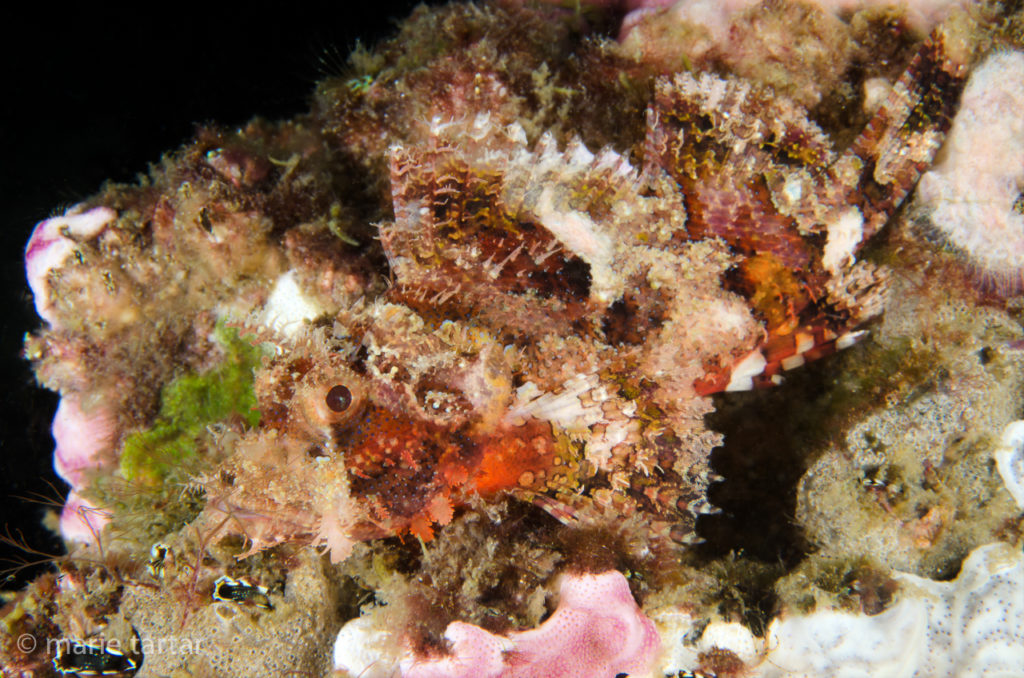
A larger subject, like a scorpionfish, is relatively easy to find, although they do an outstanding job of blending into their surroundings (Anilao, Philippines).
Finding subjects is both easy and challenging. There is no shortage, but some of the most elusive and hidden creatures require local knowledge and considerable experience, the province of the dive guides, who are the key to unlocking the region’s riches.
Sunday, April 10, 2016: Introduction to Anilao
Hydees
Secret Bay
Balanoy
Sunview (night)
Within minutes of entering the water, our guides (including Hydee himself, for whom a dive site is named) had pointed out a pair of cowries, frogfish (orange, pale peach, and hairy pumpkin-colored) and a tiny flamboyant cuttlefish, galloping along the surface of the sand. Nudibranchs, scorpionfish, and a zebra crab perched atop a fire urchin rounded out a very satisfying first day.
Tanya dove with us in the morning, and pointed out many critters and nudibranchs.
A feeding shrimp was coaxed from the base of a fire urchin into a more favorable position.
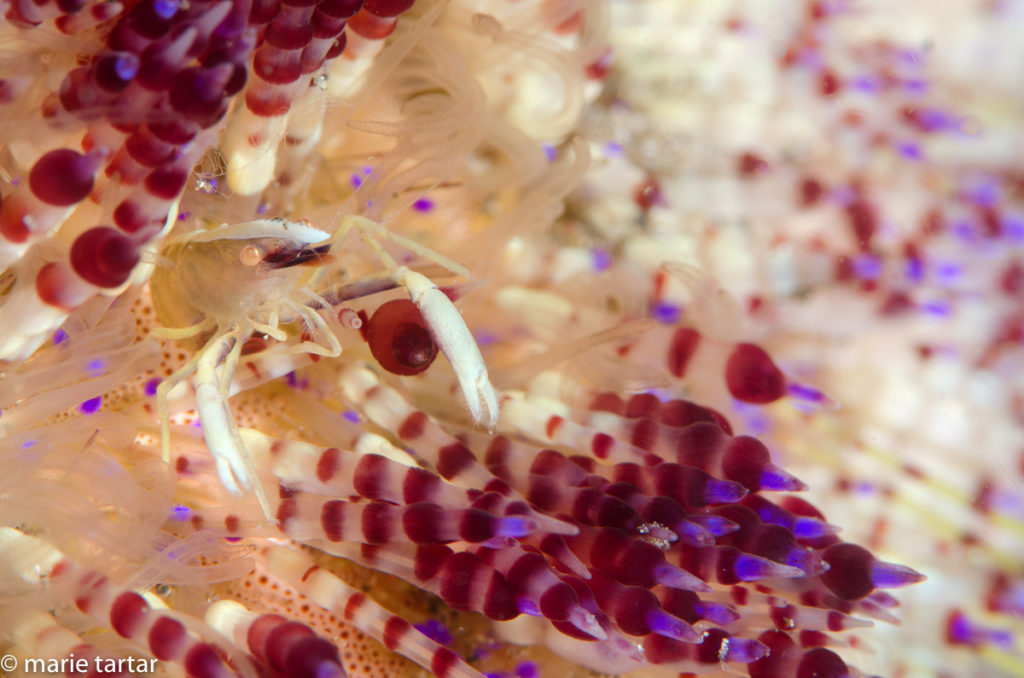
A tiny crustacean is concealed and protected in a color-coordinated home, a fire urchin, in Anilao, Philippines
My best sighting was a pair of hermit crabs, facing each other, with claws outstretched to the other, bringing to mind two children on a playground, entwined in a round of “patty cake”. This was no amorous encounter: although it initially seemed amicable, a struggle ensued, in which one temporarily overpowered the other, who beat a hasty retreat into the shelter of its shell. Then the tables were turned, and the formerly cowed caused its former oppressor to take cover. Presumably, this was a case of the shell being more appealing on the other side, with each eyeing the other’s home covetously.
The cast of characters changes at night.
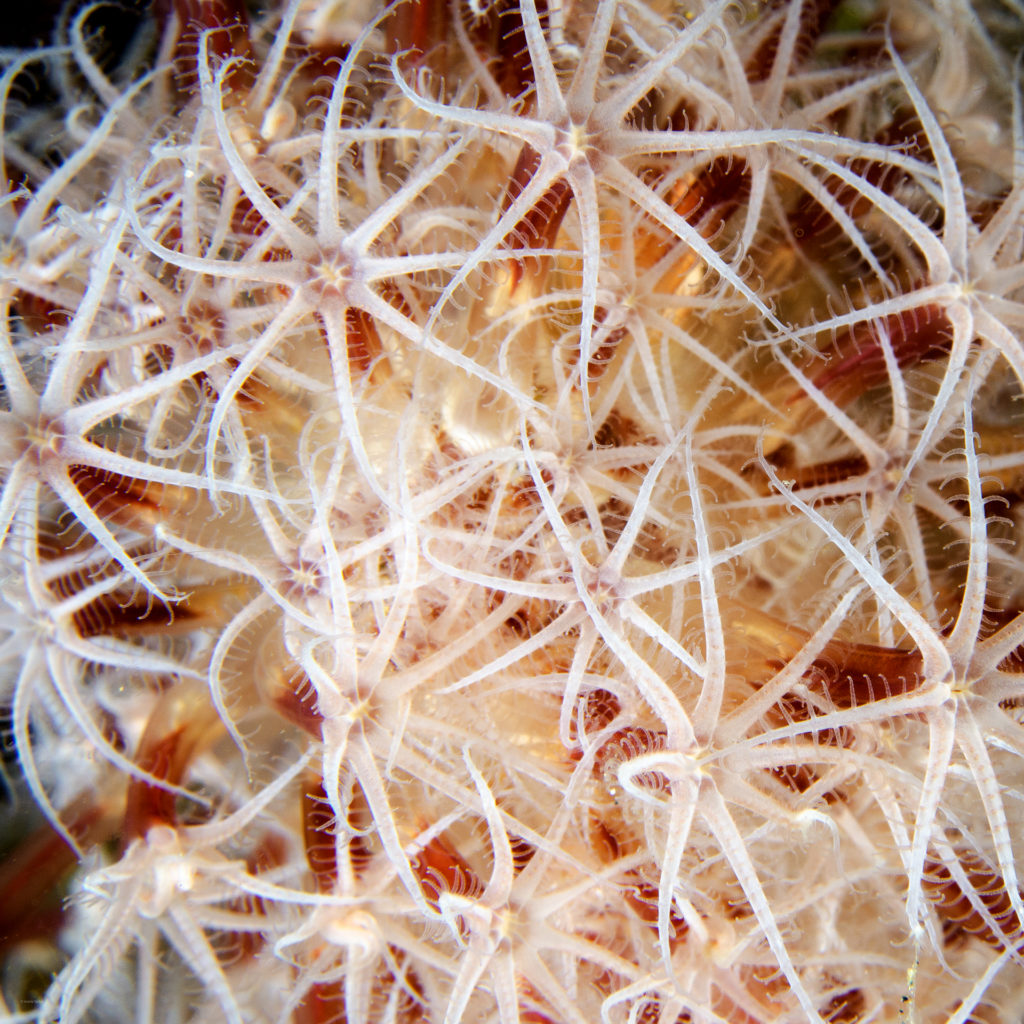
Corals extend flower-like polyps into the water column at night to catch microscopic planktonic specks.
Monday, April 11, 2016
Minilog
Kirbys
El Pinoy
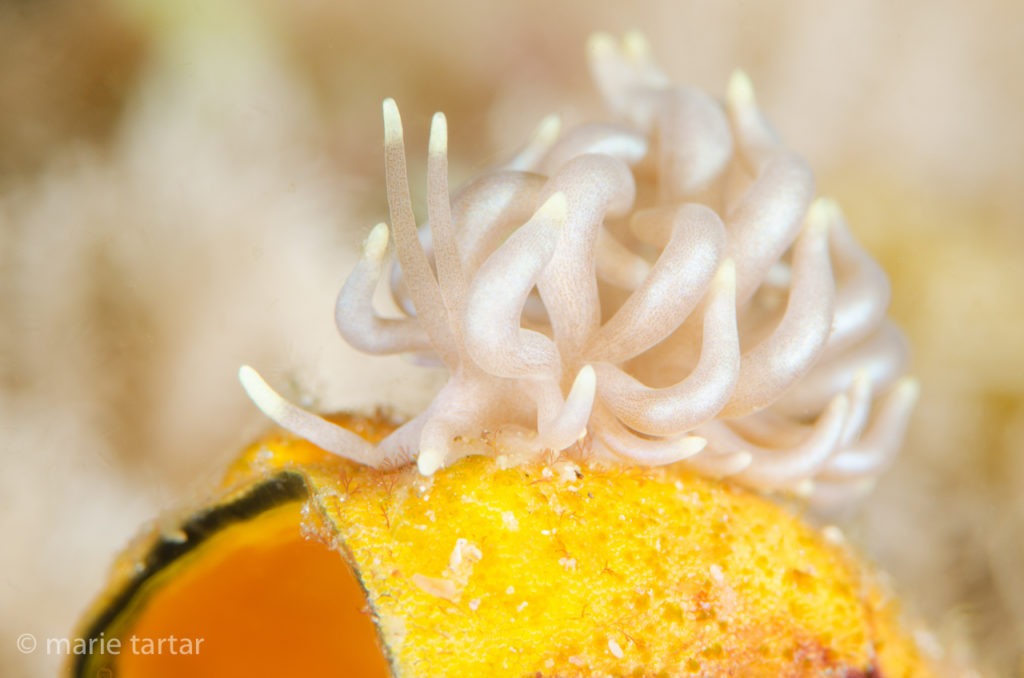
Anilao is famous for its nudibranchs; the number and variety is astounding; this beauty is a Phyllodesmium briareum. It is perched atop a sea squirt.
Tuesday, April 12, 2016
Daryl
Kirbys
Koala
Pier (night)
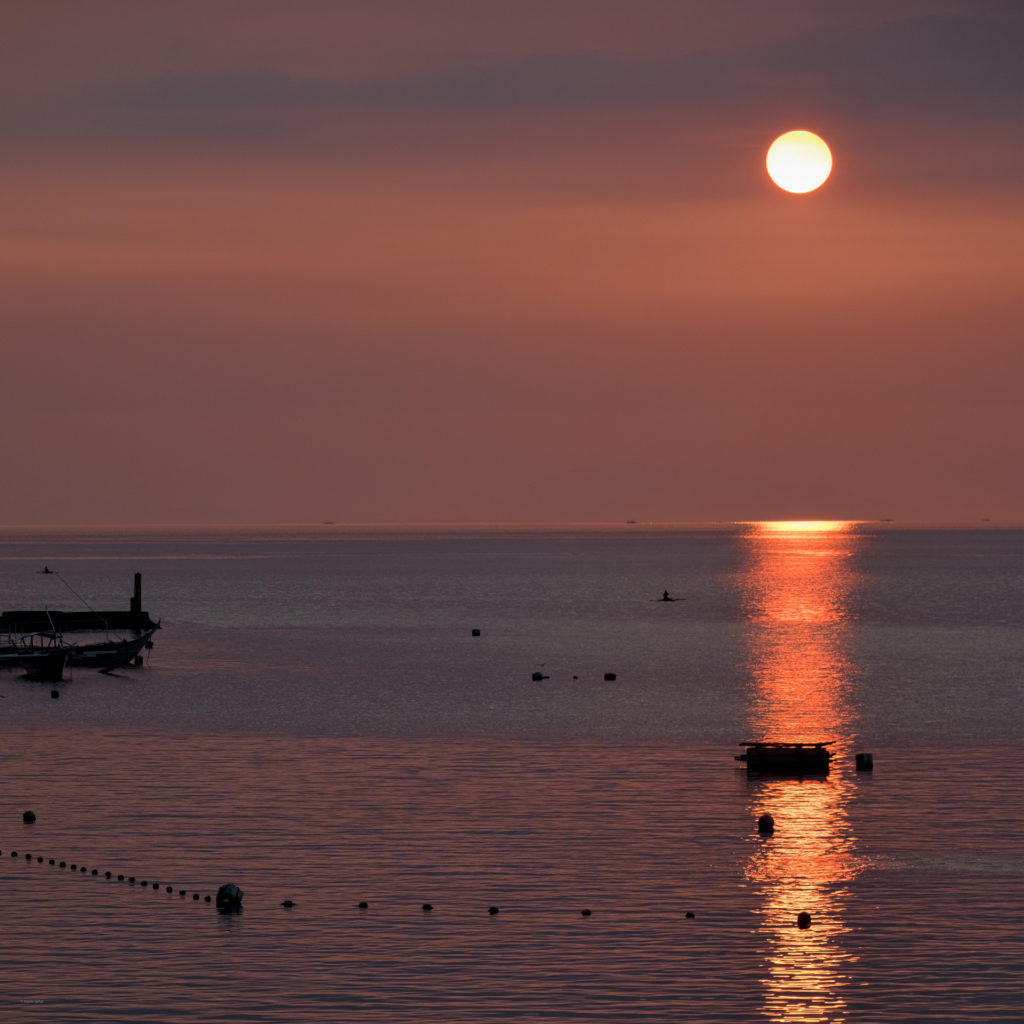
Heading out for a night dive in Anilao, Philippines (view from Aiyanar, our comfortable resort home for the week).

Leopard Crinoid Shrimp (Laomenes pardus)) at home, both sporting matching candy-stripes, Anilao, Philippines

Elegant squat lobsters (Allogalathea elegans) are normally secreted deep inside host and home crinoids; this one seemed content to squat in the open on a tunicate (Green Barrel Sea Squirt – Didemnum molle); Anilao, Philippines
Wednesday, April 13, 2016
Bethlehem
Sombrero
Dead Palm
A sandy, rocky, algae covered shallow slope led to a mini concrete wall. We had hardly entered the water when the frantic guide flashing started-a tiny ghost pipefish, golden hued, matched in frailty and shimmering to algae clumps.
The next clump of golden algae sported a decorator crab, tiny and well concealed in his matching hues.
Steve was huddled on the sandy slope, matching wits with a tiny bright orange hairy frogfish. The water was alive with translucent shrimp which pelted us and at which the tiny angler fish lunged periodically.
Before entering the water, the dive guides had said confidently that we would see Coleman shrimp on fire urchins, and they did not overpromise. I had to elbow Steve out of the way to have a turn with a pair on top of the large colorful urchin.

Coleman shrimp pair perch on their matching home, a fire urchin; using their clipper claws, they snip off spines to clear off a space for themselves.
Further down , I found a tiny anemone sporting a dozen Ambonian shrimp, the best shooting situation for this creature I’ve ever encountered. Steve moved back in on the Coleman shrimp as soon as I edged away.
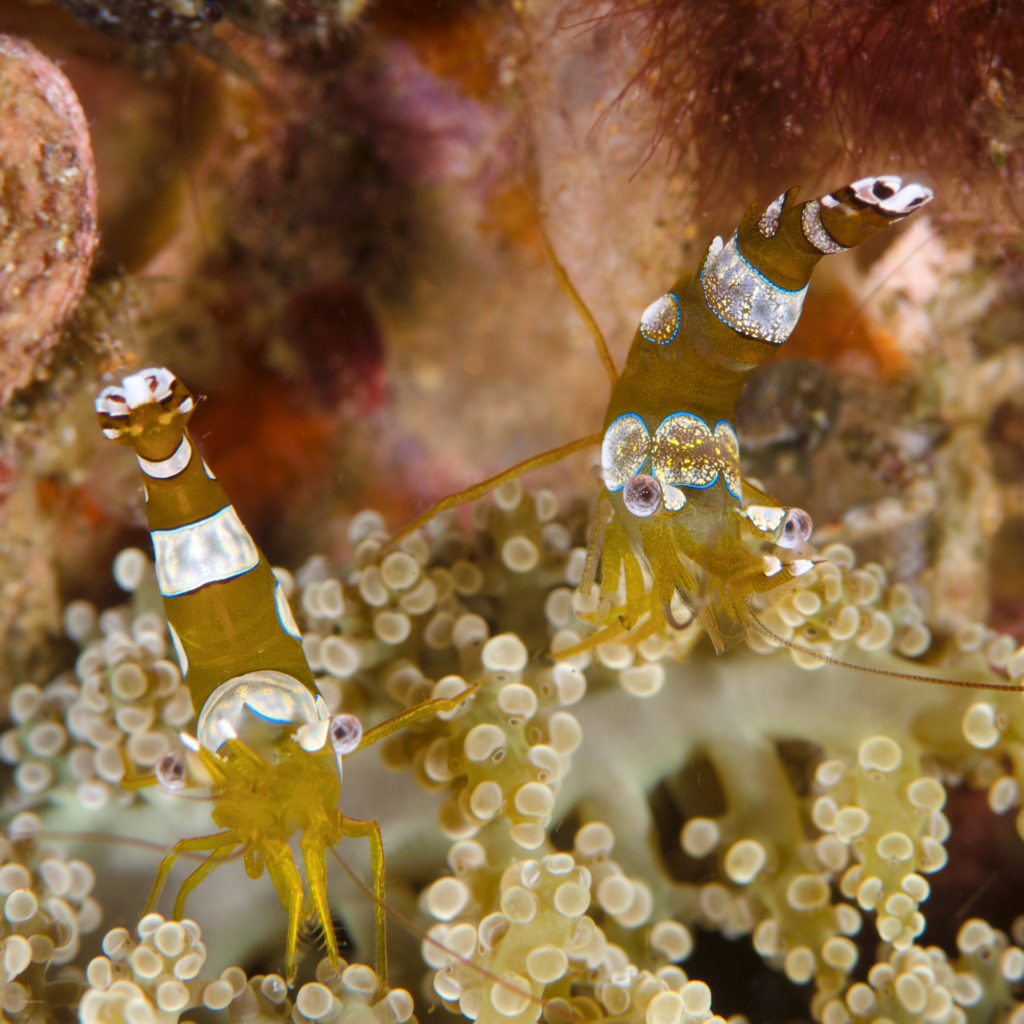
The things one learns from the Internet! Searching for the scientific name (Thor amboinensis), I learned these are also known as sexy shrimp?! I still have no idea why.
Taking a second turn with the Coleman shrimp, I found out the hard way how apropos the name “fire urchin” is. Stretching my legs out behind me over algae covered rocky slope, both knees received electric jolts of fire which really hurt for several minutes.
Trailing behind the group, I found a pair of cream and burgundy frogfish. Doing the same dive a couple of days later, we were to see this same pair in nearly identical positions.
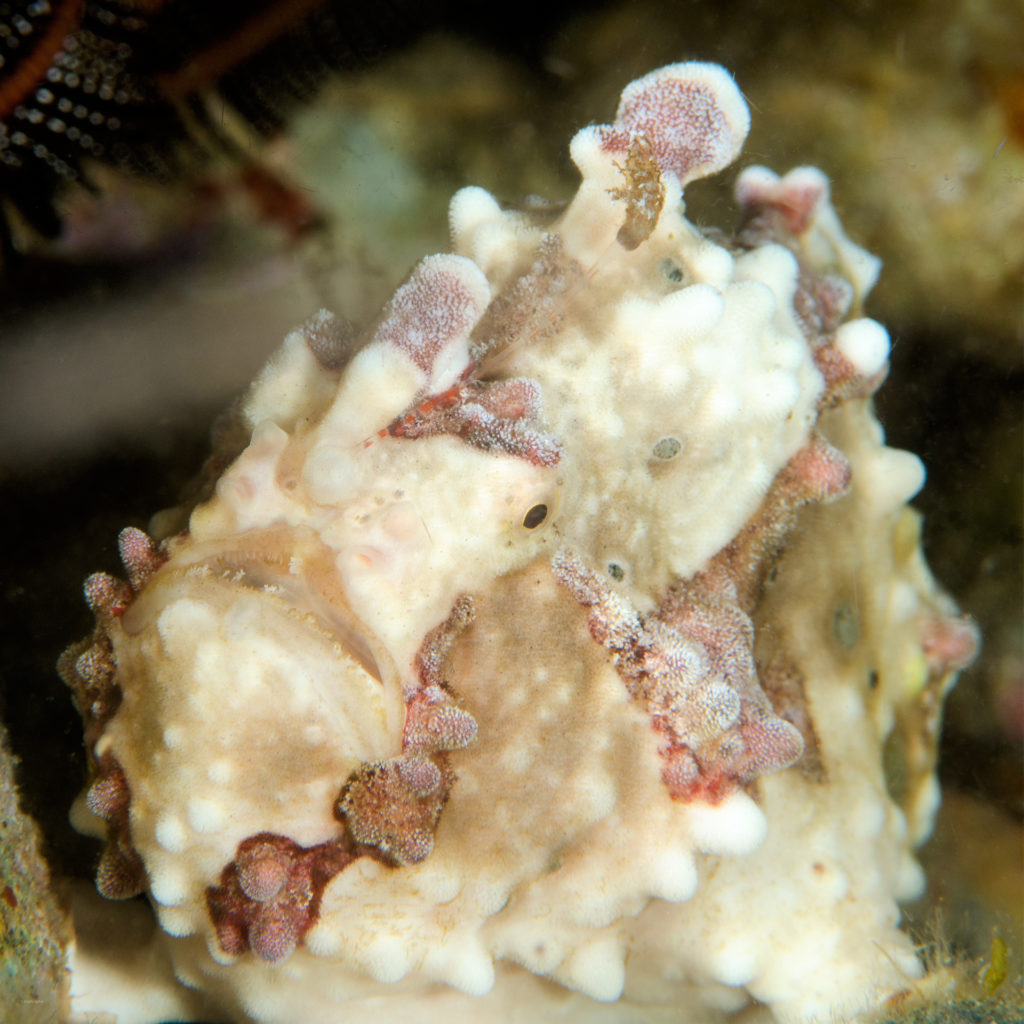
A bumpy beauty of a frogfish in Anilao, Philippines (aka Warty or Clown frogfish (Antennarius maculatus))
Thursday, April 14, 2016
Hydees
Cayzer
Matu
The morning’s dives were some of the best ever. First stop was Hydee’s, named for one of the dive guides. We had stopped there the first morning out, with Hydee himself, but were dissuaded by the number of boats already at the site.
Although there were again at least 5 other boats already there, we persisted this time. A pair of Emperor shrimp adorned either end of a striped sea cucumber.
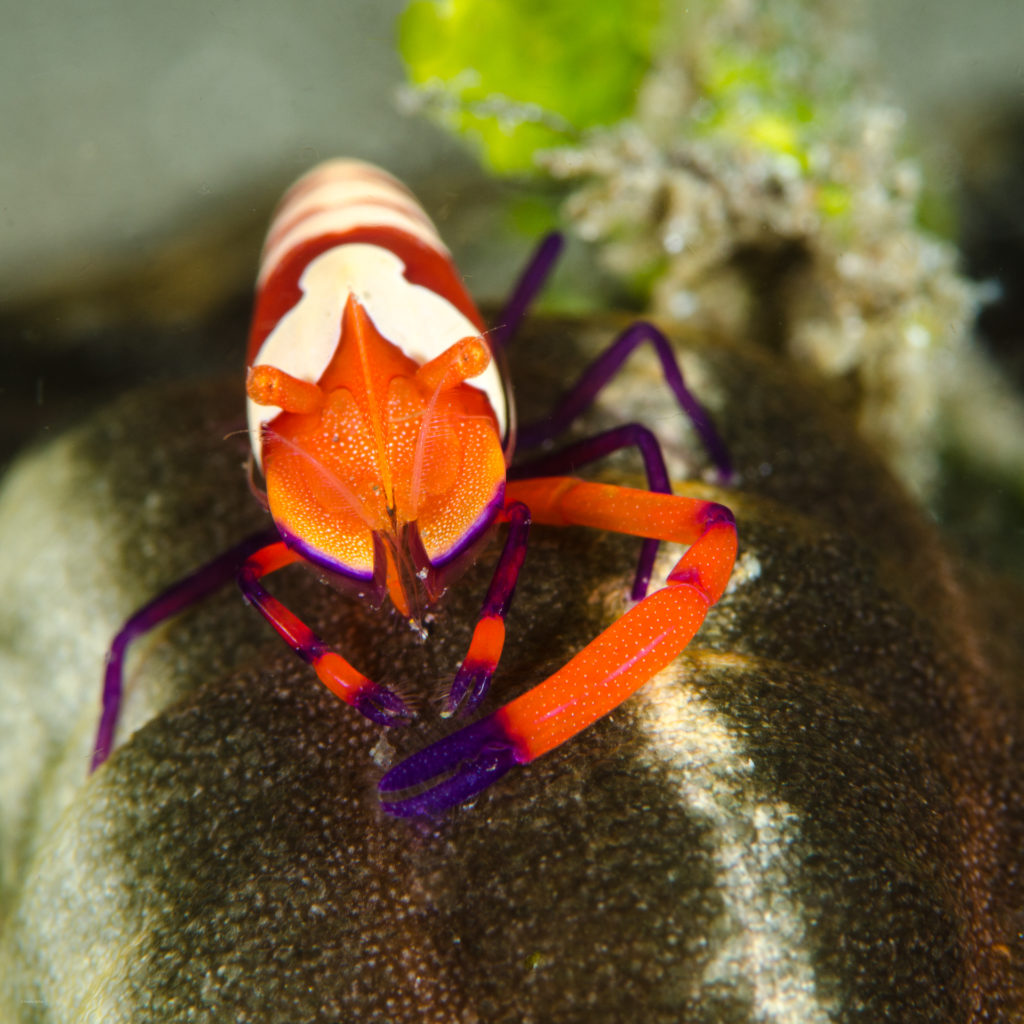
Emperor shrimp (Periclemenes imperator) astride his slow-moving home, ride and companion, a sea cucumber, Anilao, Philippines
A coconut octopus was coaxed from outside its shell home by placement of a short stick outside the entrance. The octopus threw an arm out to investigate and soon was outside.

The coconut or veined octopus, Amphioctopus marginata, makes use of a shell as a portable shelter; coconuts or bottles can be pressed into service as well.
In dizzying succession, the guides pointed out a miniature hairy orange frogfish, a cuttlefish, a brown Ambon scorpionfish, a soft coral crab, a pale peach frogfish and a miniature cuttlefish.

Years ago, in Milne Bay in Papua New Guinea, we dove repeatedly to 100 foot depth to shoot a single flamboyant cuttlefish (Metasepia pfefferi) like this; what was a rare sight there is extremely common in muck diving hotspots like Anilao and Lembeh, Indonesia.

Pteroidichthys amboinensis (Ambon scorpionfish), named for another famous muck diving site, in Indonesia
The guide had a black board with him as an alternate backdrop for the soft coral crab. By this time, the sand was churned up by errant fin kicks and a group of bicycling inexperienced divers from another resort.
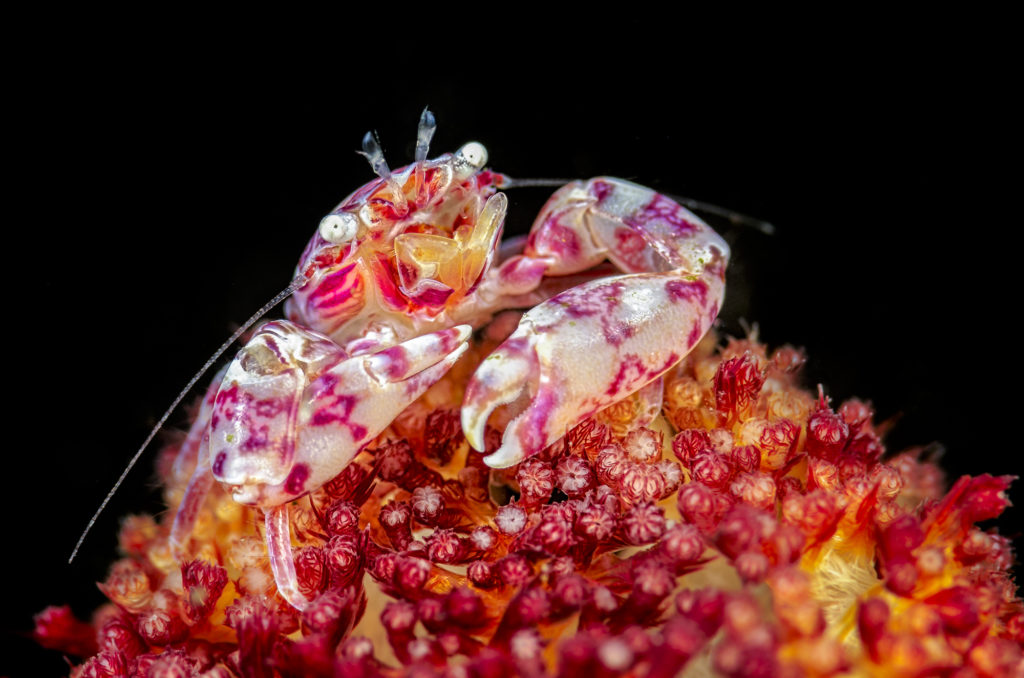
An outrageously colored soft coral crab perches like king of the hill on its home in Anilao, Philippines.
Our guide pointed out and corralled a fire urchin shrimp while I shot it. At this point, we were at 60 foot depth and it was time to head up. The guide swam up the slope. Greg was also starting his ascent just ahead of me. Just as I turned to swim up the slope myself, I caught a flash of brilliant blue out of the corner of my eye and turned back to check it out. I couldn’t believe my eyes when I realized it was a blue-ringed octopus, out in the open, marked by the unmistakeable brilliance of its Yves Klein blue rings.
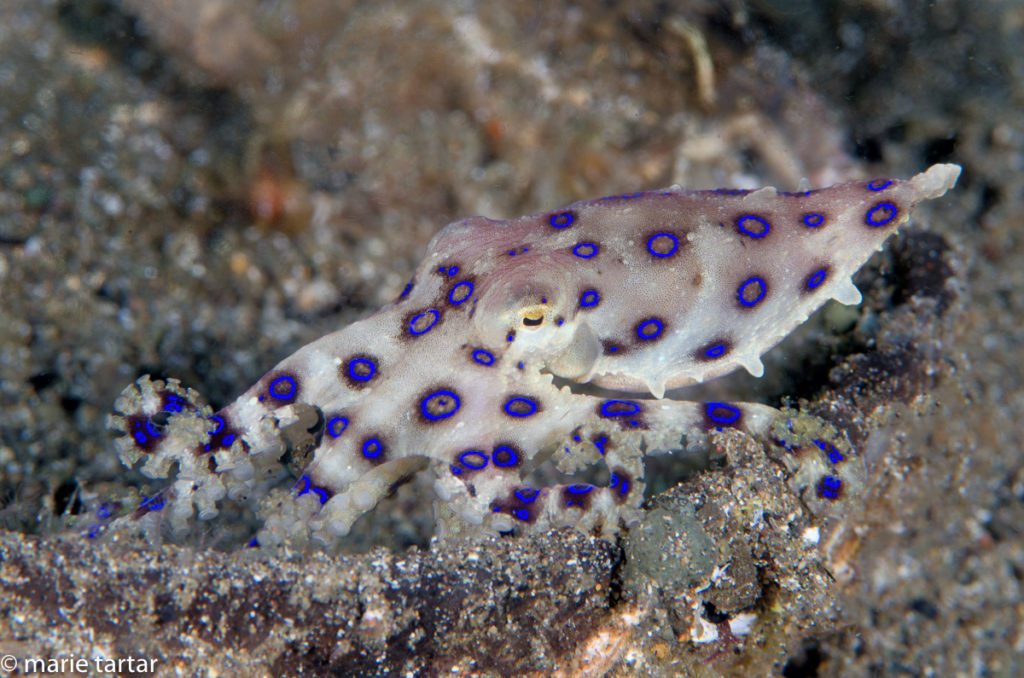
A gift from Anilao, my very own blue-ringed octopus! I was just starting to head upslope after Greg and our guide at the end of the dive when a flash of blue caught my eye and caused me to turn back and look again! (Blue-ringed octopus in “keep on trucking” posture, in Anilao, Philippines)
I banged my tank and screamed into my regulator, but Greg didn’t hear me. I was able to get off only a couple of shots before it darted away, its body streamlined into a pulsatile projectile. Thankfully, it stopped periodically on new perches, so I had several opportunities to capture it again in all of its blue-ringed glory.

My first time to FIND a blue-ringed octopus; usually they look like amorphous clumps of brown algae UNTIL they start to flash their blue rings in warning.
Whatever blue-ring lust the others must have felt after I returned tardily to the boat was soon slaked on our second dive, to Cayzer, where there was another blue-ring octopus out in the open, seemingly swollen to 3 times its normal size, as it engulfed and worked on digesting a much bigger crab. It was so expanded by this endeavor that at first glance I thought it must be 2 blue-rings mating.

At first glance, this blue-ringed octopus appeared to sport unusual claw-like tentacles. They actually belong to the tasty crab it has pinned underneath and is ingesting.
Friday, April 15, 2016
Coconut and Cayzer
Hearing we had epic dives the day before at Hydee’s and Cayzer, our new set of guides decided to take us across the channel to Coconut. First stop for me was an adorable tiny soft coral crab, whose tan and white coloration was perfectly coordinated with its flowery home.
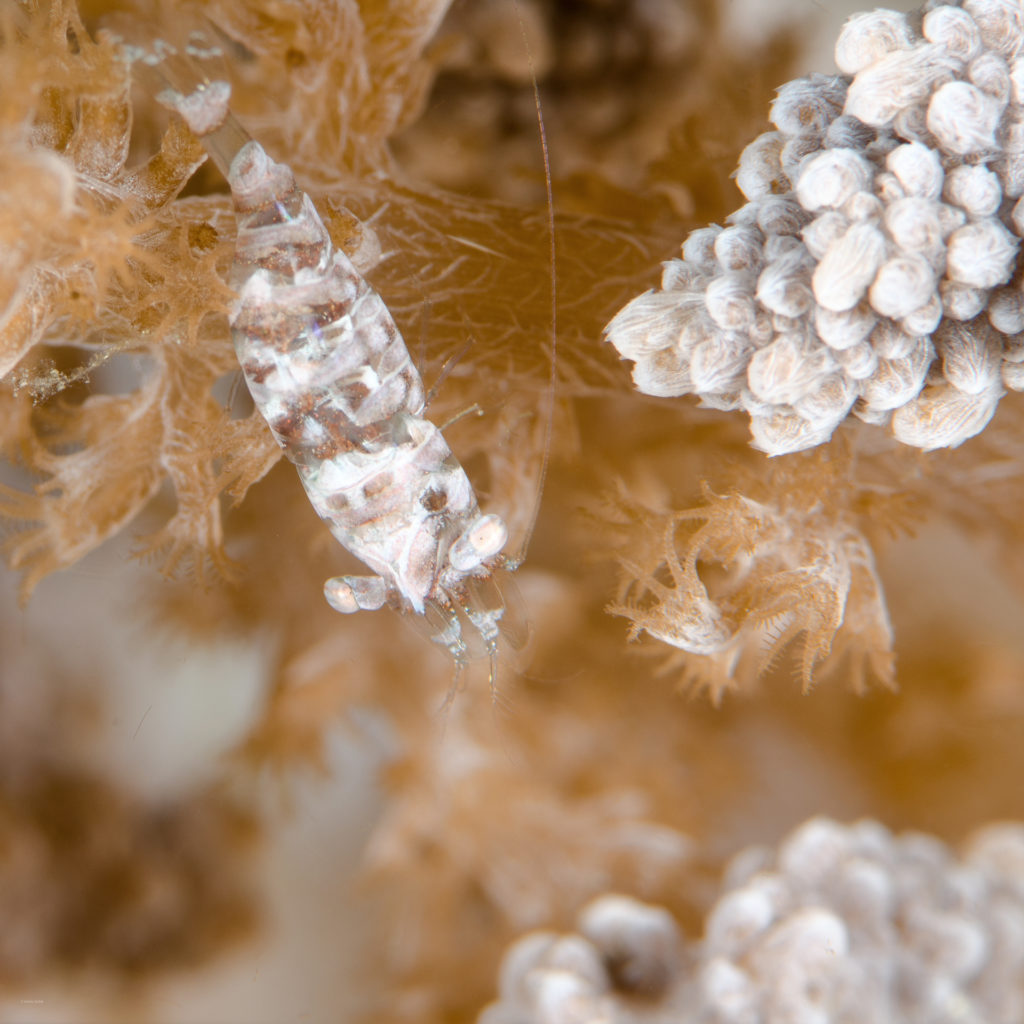
Well matched to its substrate: Humpback Soft Coral Shrimp (Alcyonohippolyte dossena), Anilao, Philippines
While Martin worked a frogfish at one end of a rotting log, we occupied ourselves with a pair of colorful dragonets at the other end, dragging themselves across the sand.
Tanya had mentioned this was a season in which pairs of tiny yellow gobies could be approached, as they guarded their eggs, but I hadn’t yet seen them. In fact, when the guide pointed out a pair ensconced in half of a coconut shell, I wasn’t surprised I hadn’t noticed them: they are minuscule! I had an even better opportunity to admire their attention and industry later, with another pair, who set up shop in an old bottle.
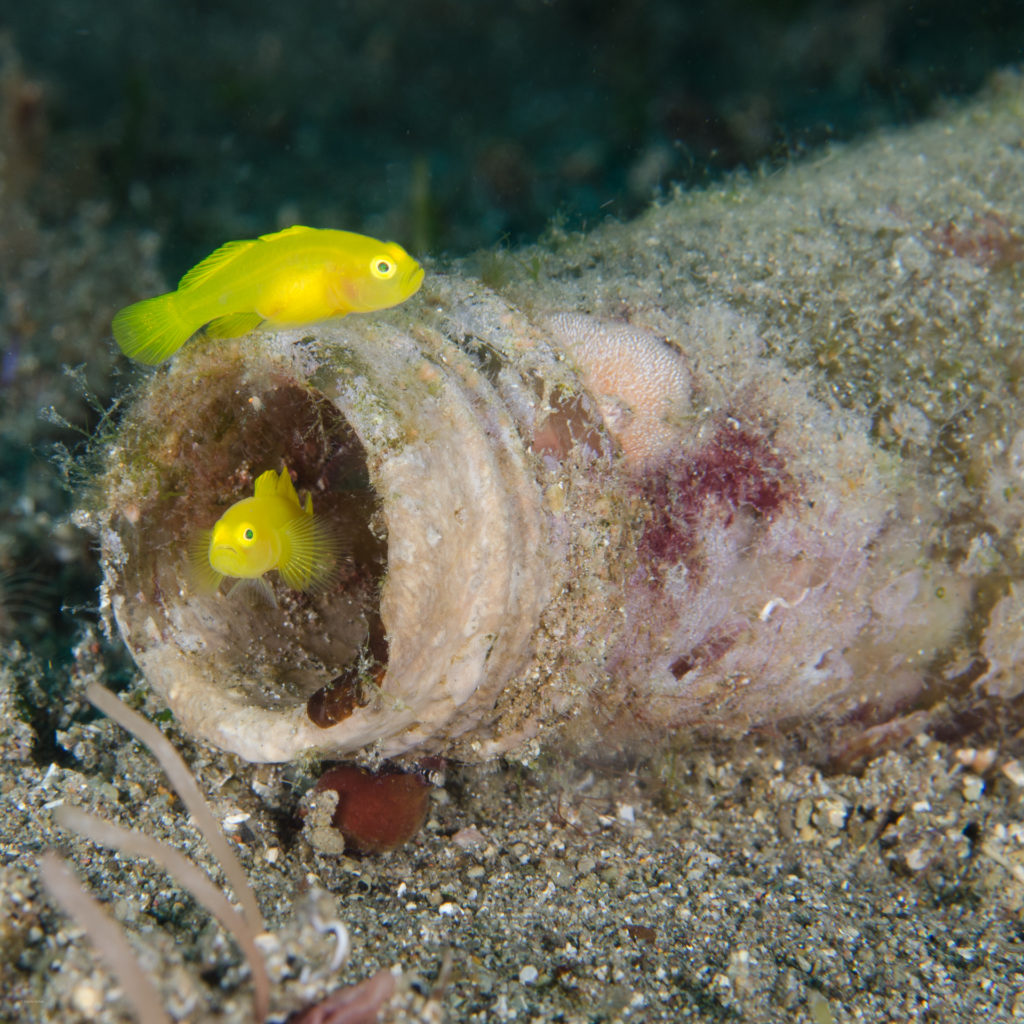
A pair of anxious parents-to -be: Yellow Pygmy Gobies, Lubricogobius exiguus, stand guard as their eggs develop (the pearly peach patch on top of the repurposed bottle), Anilao, Philippines
Periodically, they were menaced by a patrolling black damselfish, as well as a striped blenny, who may well have been displaced from the bottle by the pair, this being its customary preferred type of residence.
Greg discovered the hard way, underwater, that he was shut out from shooting, having forgotten to put a card back in his camera. So, he was spotting for us during the first dive, and came up with a beauty: a cowrie in a small soft coral tree.
Martin came to his rescue on our between dives surface interval, pulling a card out of his camera. Greg amused us by manually sucking on his camera, succeeding in pulling a partial vacuum with his lungs.
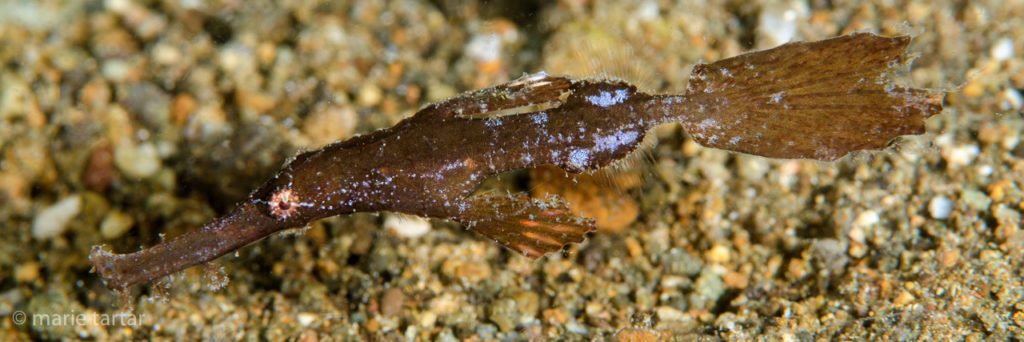
Another favorite creature: robust ghost pipefish (Solenostomus cyanopterus) hovers above the sand in Anilao, Philippines
Our last dive together was a return to Cayzer. As befits a farewell to diving for a while (in our case until September), this final dive featured some of my favorite creatures. A tiny translucent slip of a harlequin ghost pipefish wafted above the sand.
Later, I found a handsome seahorse, my pleasure in seeing this improbable creature magnified by finding it on my own.
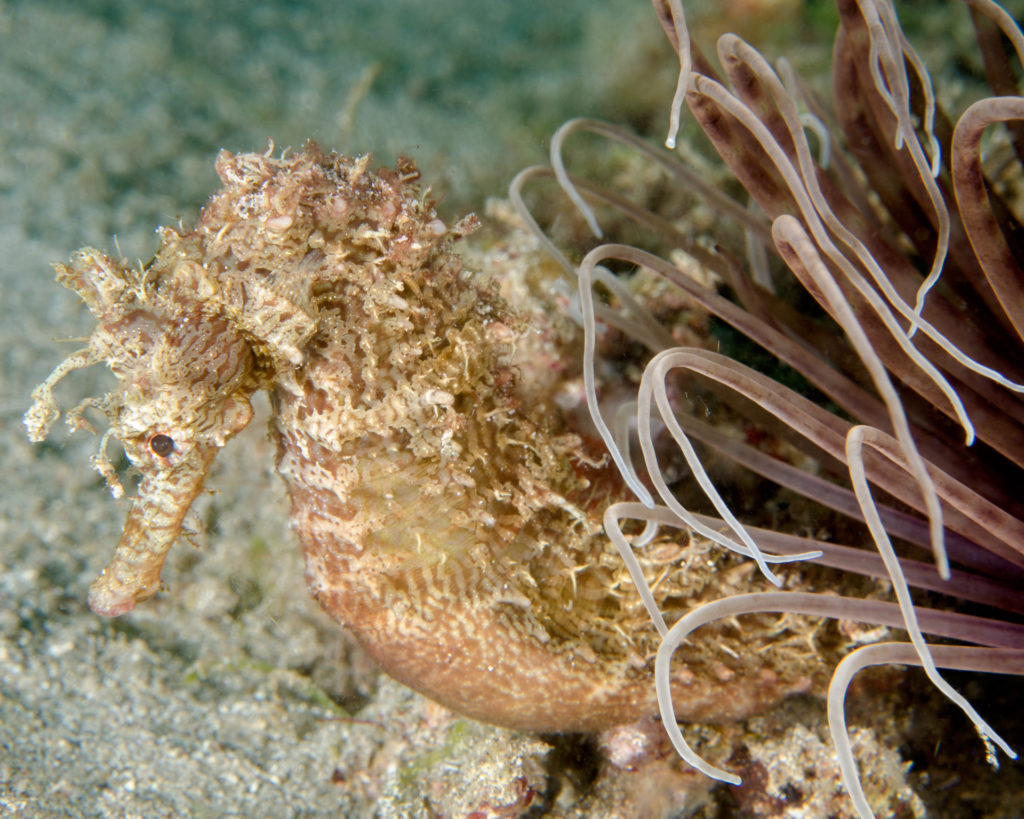
A bigger subject, like this seahorse, are the only subjects these aging eyes have a chance of finding on their own.(Thorny seahorse, Hippocampus hystrix, Anilao, Philipppines)
Steve and Martin decided to skip the last, after lunch dive, to give the gear a chance to dry before packing. After the should-be-3-hours-but-took-almost-5 land transfer inbound, we were taking no chances. Instead of a dark o’clock early morning trip, hoping that traffic and construction would cooperate, planned for our departure the following morning, we decided on an after dinner transfer, and had booked 2 rooms at the Belmont, the “airport” hotel in which we had stayed on our trip in. It still astounds me that one cannot walk from the domestic to the international terminal in Manila, and that though we could see a terminal from our window at the Belmont, it was at least a 20 minute drive away.
After lunch, I vacillated, wanting to dive again, but knowing there were hours of camera breakdown and packing ahead to fill the afternoon, so I eventually changed my mind in favor of bagging it. Greg was set on diving, but used to our customary “second wave” timing, came down too late, to find the boat he was supposed to go with had left without him. He settled for a guide-accompanied shore dive instead, thus keeping intact his “never skip a dive” policy.
After packing and running around the resort gathering up stray items, I was heated up enough to finally take a short sunset swim in the lovely infinity edge pool I had been dashing past all week.
Part of my afternoon was given over to actually looking at the jewelry being proffered at the resort’s edge by malnourished appearing plaintiffs. Each time we descended the concrete stairs leading down to the waterline and the waiting dive boats, and each time we trudged up dripping in wetsuits, they were there. Holding fistfuls of pearls and clutches of necklaces, they called “Ma’am,” “Maybe tomorrow,” and other snatches of English phrases. This final morning, I had actually glimpsed something that interested me, large simple white pearl earrings, a wardrobe staple I had misplaced that needed replacing.
I didn’t have the heart to haggle too much, and ended up with a long strand of white baroque pearls for $60 (unplanned) and a set of large white pearl earrings for $40 (planned).
The whole resort was a bustle of activity, as the staff mobilized to reposition the tables and chairs from the upstairs open air dining room down onto the poolside lawn for the grand finale barbecue and slideshow. A big screen TV was rigged up, and cocktail hour was down on the lawn, the bar having also been relocated for the festivities. I took the opportunity to finally try some local spirits, including a lychee liqueur and one made from a local citrus.
Dinner featured a late arriving roasted suckling pig, a Philippine version of shave ice dessert station and an assortment of diver and sealife adorned cakes.
Not knowing if our after dinner transfer would again take many hours or would avoid traffic and construction delays encountered on the way in as we hoped, we mobilized to pull out of the resort at 10:30 pm. Greg had decided at the last minute to come with us rather than on the following morning’s 5 am transfer for which he was scheduled, so we scurried around helping him get together his still wet gear and scattered belongings.
The van driver talked non-stop on his cellphone but still managed to swerve and avoid scooters without lights, trucks coming the opposite direction with inches to spare and closures of lanes on the narrow, 2 lane highway, getting us to the hotel in a record 2 hours!
Steve with his yucky throat and increasingly insistent cough and Greg who was also developing symptoms were relegated to the 3rd row of seats, the quarantine section, while Martin, also harboring symptoms, was banished to the front. This left me in the middle row, with no working seatbelt. Eventually, to not see the road, the swerving, and to tune out the driver’s incessant chatter, I stretched across all 3 seats and managed a little sleep.
The Belmont Hotel had transmuted in our absence into the Belmo T, one of the neon letters having perished in the last week. The lobby was packed, despite it being nearly midnight, thanks to a large group of young Iranians (wearing jackets that said Iran in huge letters on the back) checking in at the same time. An older man, presumably a chaperone or coach, was complaining bitterly at the front desk to a patient Philippine clerk, waving a handful of keys, that they had to have rooms closer to each other. It wasn’t enough that they had rooms on the same floor. I could see from the clerk’s face that this argument was going nowhere.
As for us, this was an obstacle between us and our beds and a long trip home the following day. It had been a ridiculously productive week, with so many images to assess that over 2 years later, at this writing, it is still not completely done!
-Marie

Sex on the reef, between a pair of Nembrotha lineolata nudibranchs. Nudis are hermaphroditic. Each extends a gonopore to the other, through which reciprocal transfer of sperm occurs to the other’s oviducal opening.
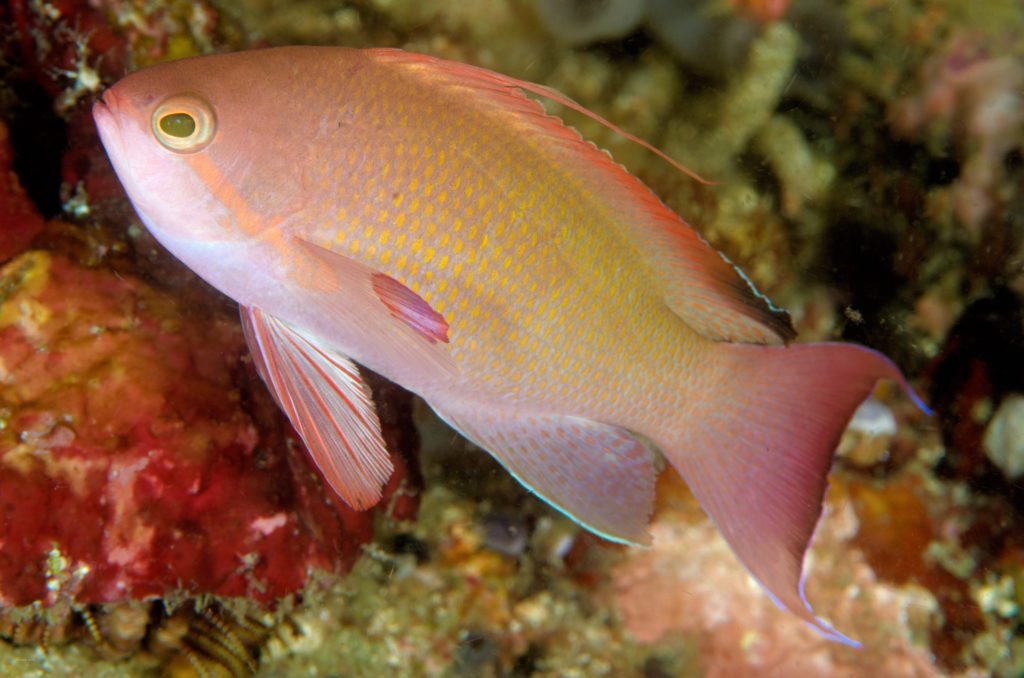
I’ve posted so many nudibranch and critter images from Anilao, Philippines, one might think there are no fish there, which, of course, is not the case. This is a scalefin anthias (Pseudanthias squamipinnis).

Pygmy seahorses (Bargibanti hippocampus) are so microscopic, they are extremely difficult to see, much less to photograph. Dive guides point them out, but in the second it takes to reposition your eye behind the viewfinder, they disappear visually into the matching Muricella gorgonian substrate. It has been proven that these miniature seahorses match their color and texture to the home once selected. Bargibanti was the first pygmy seahorse to be recognized, in 1969, the others were all named after 2000.

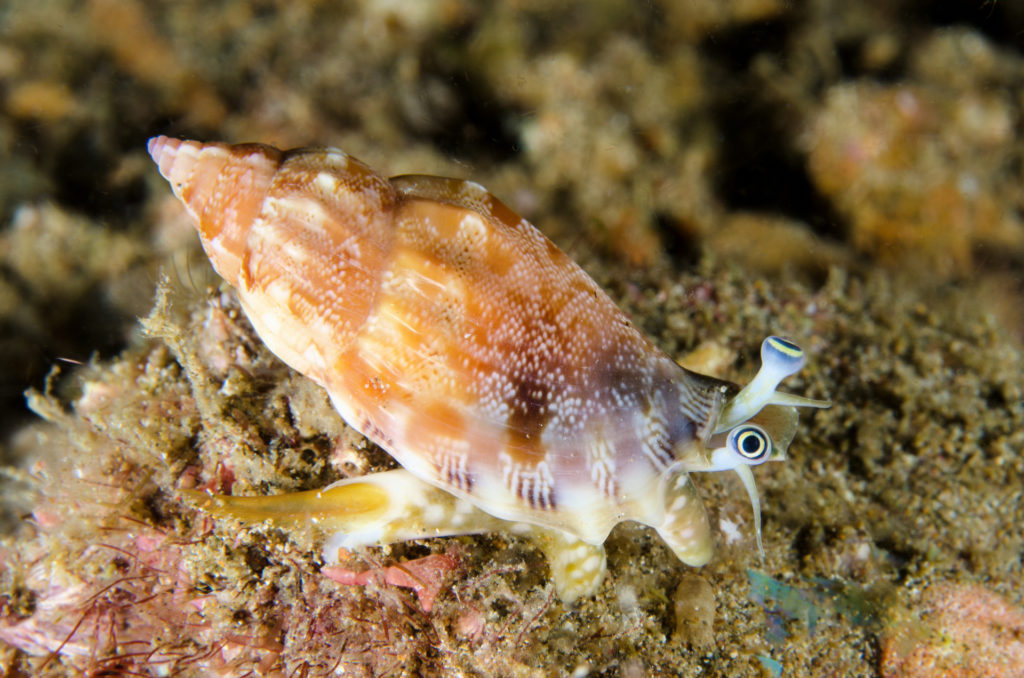
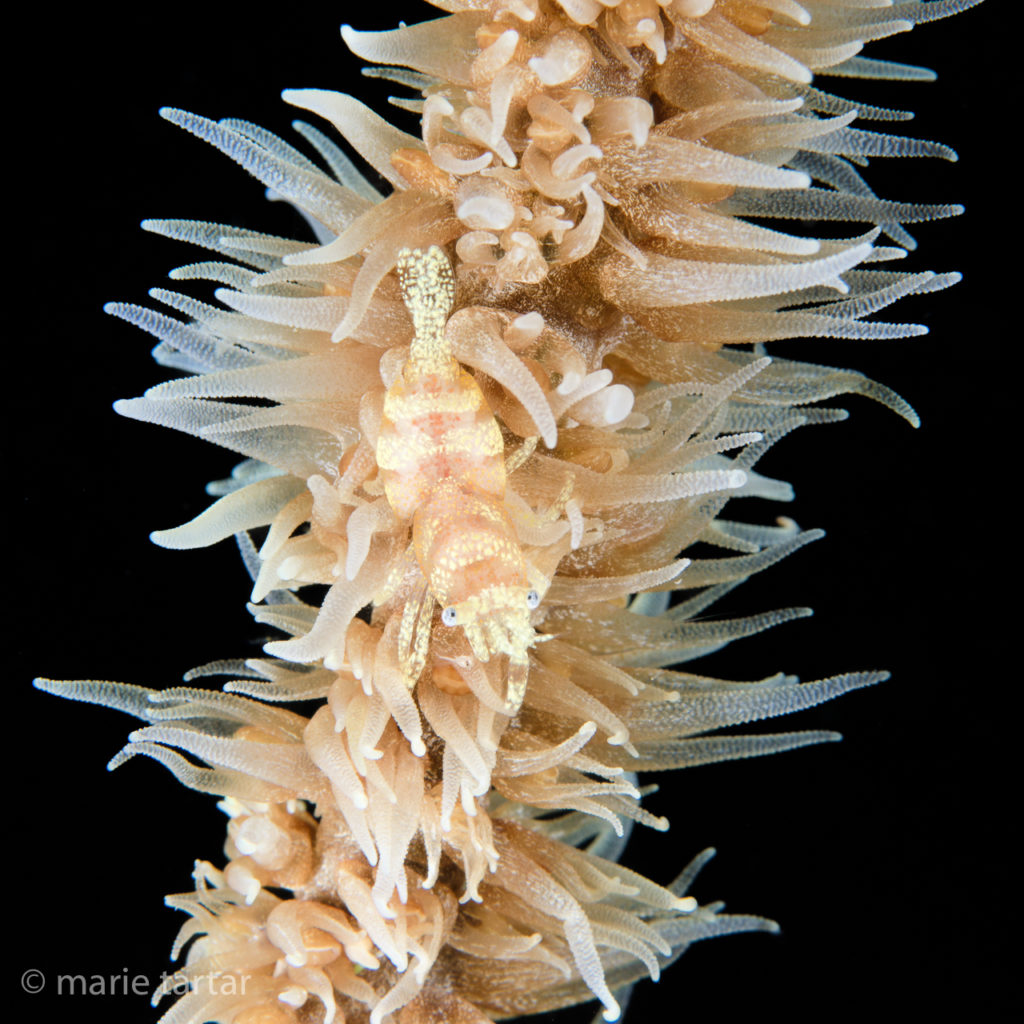

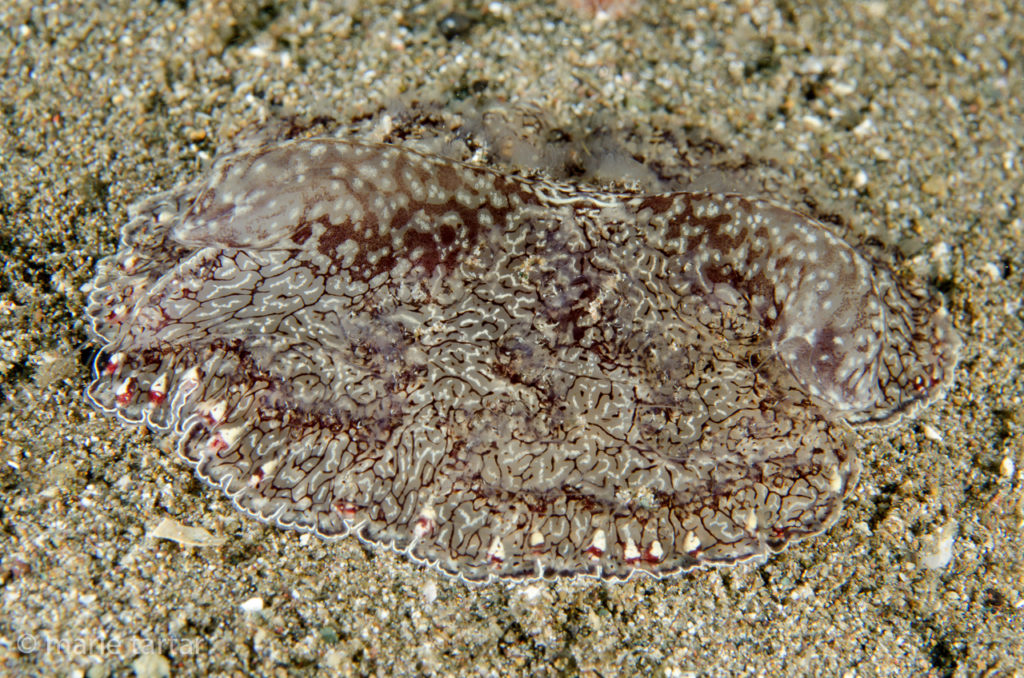


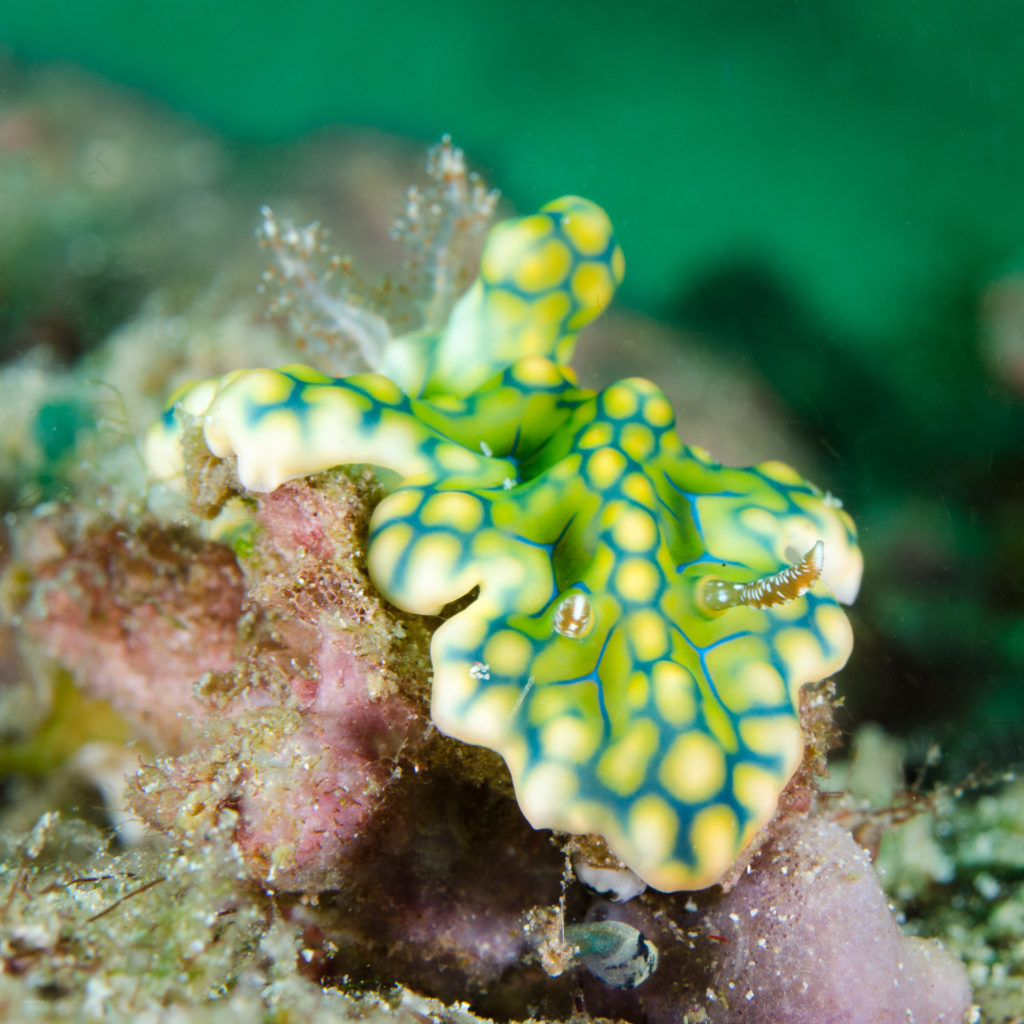
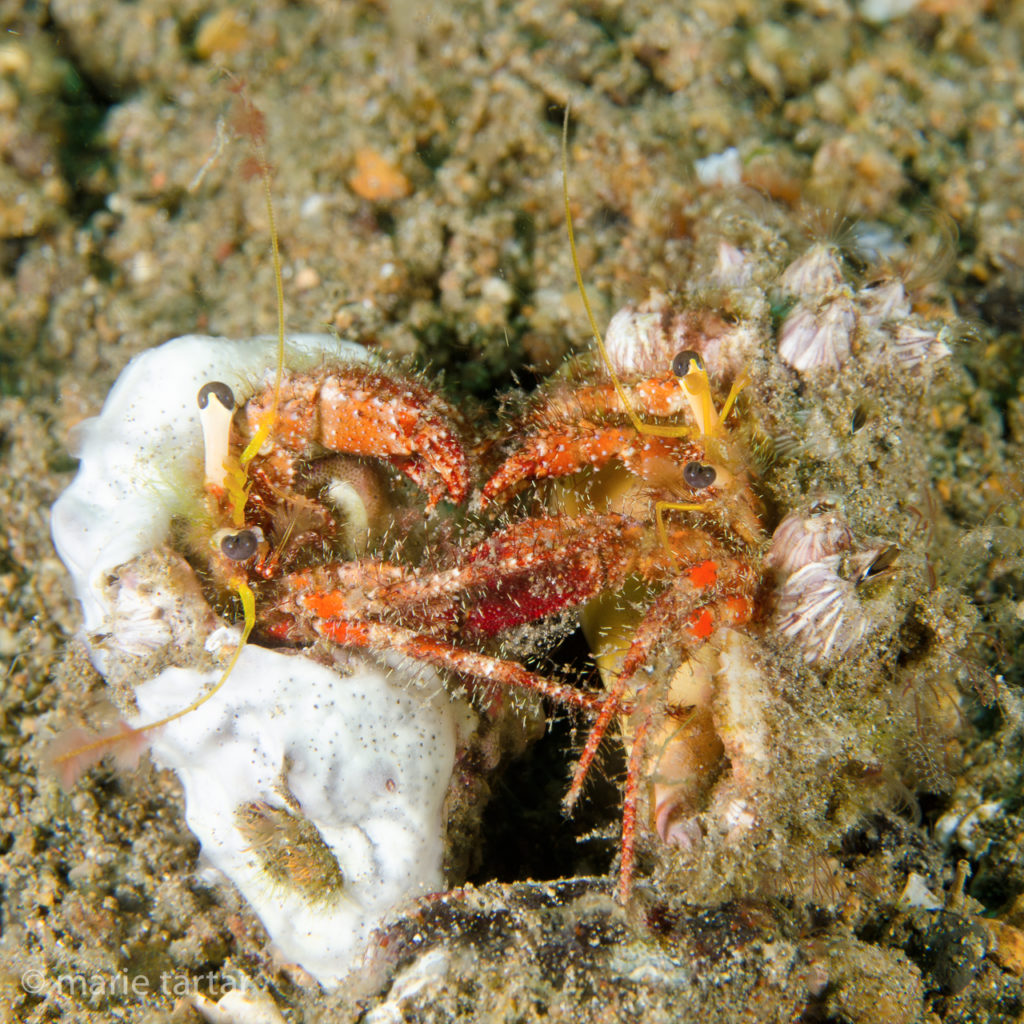
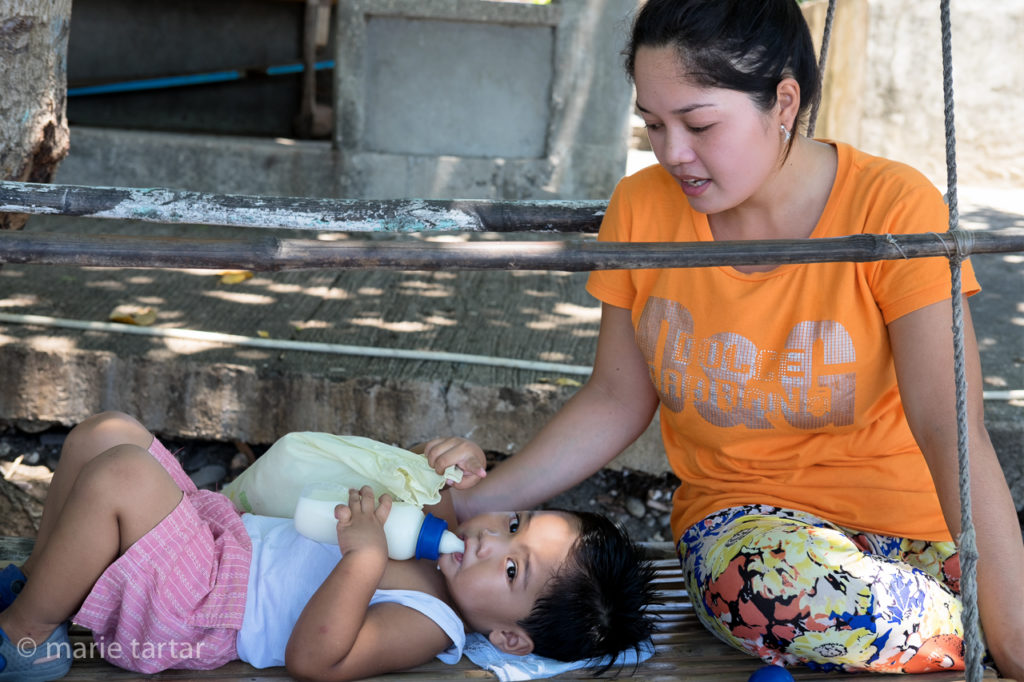


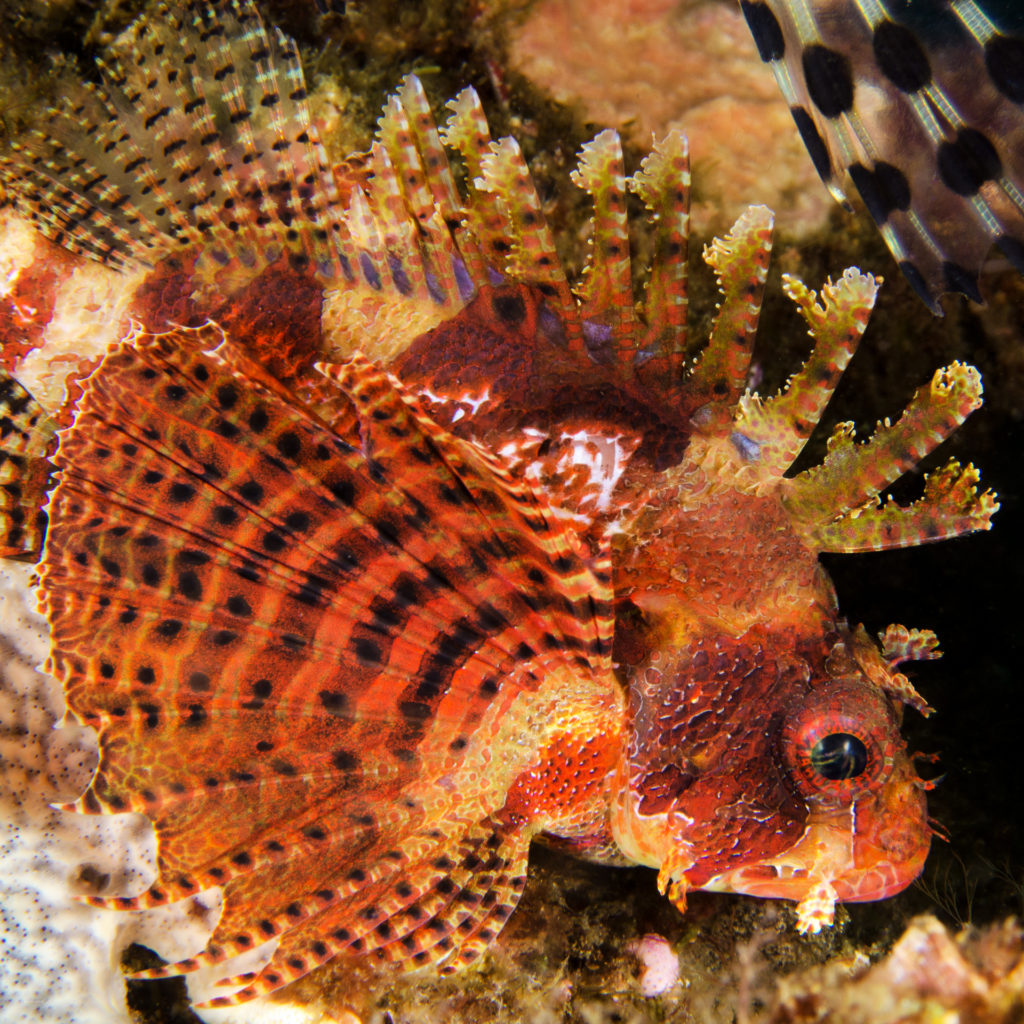
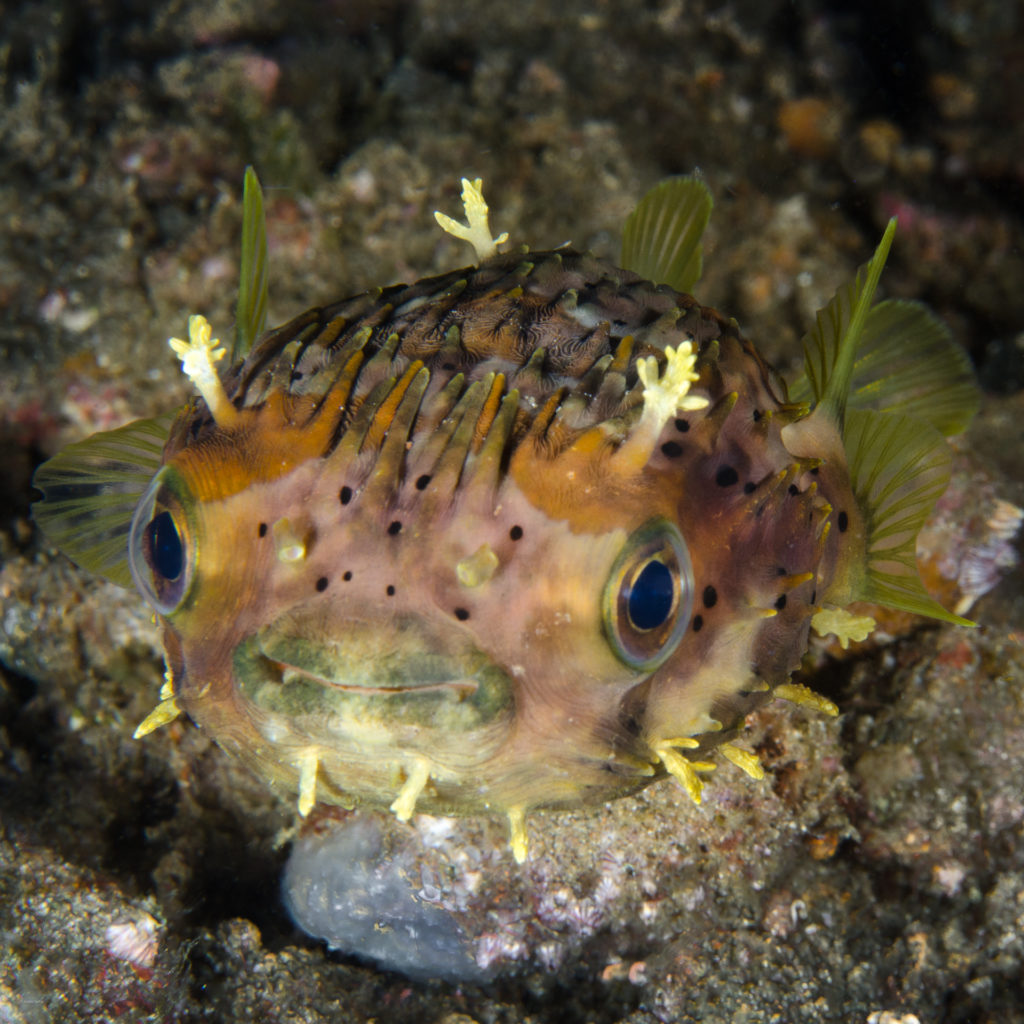
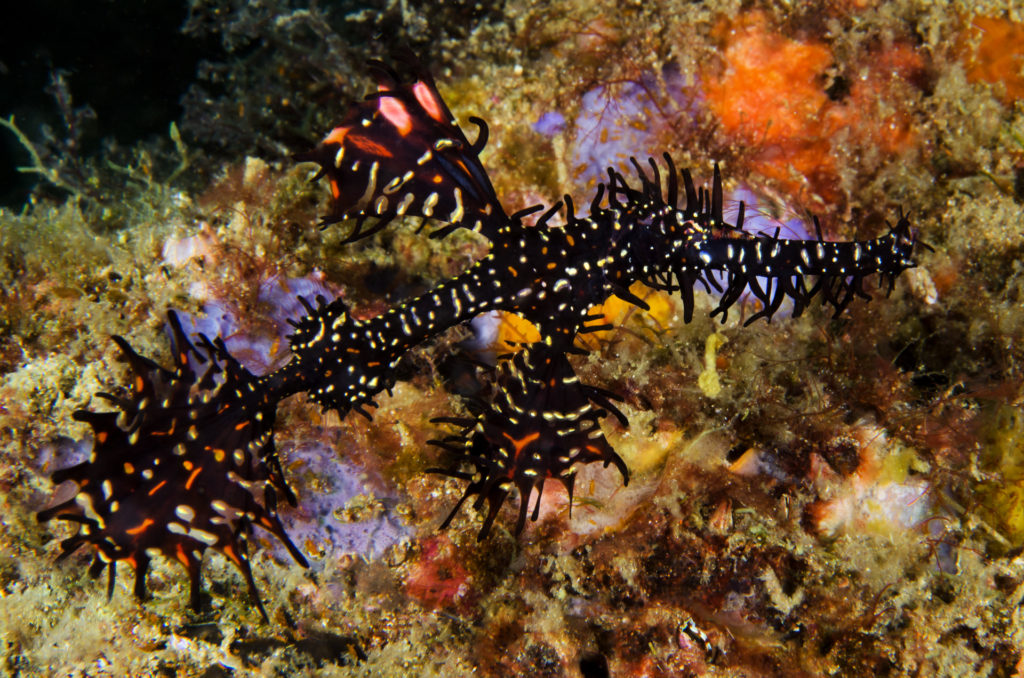
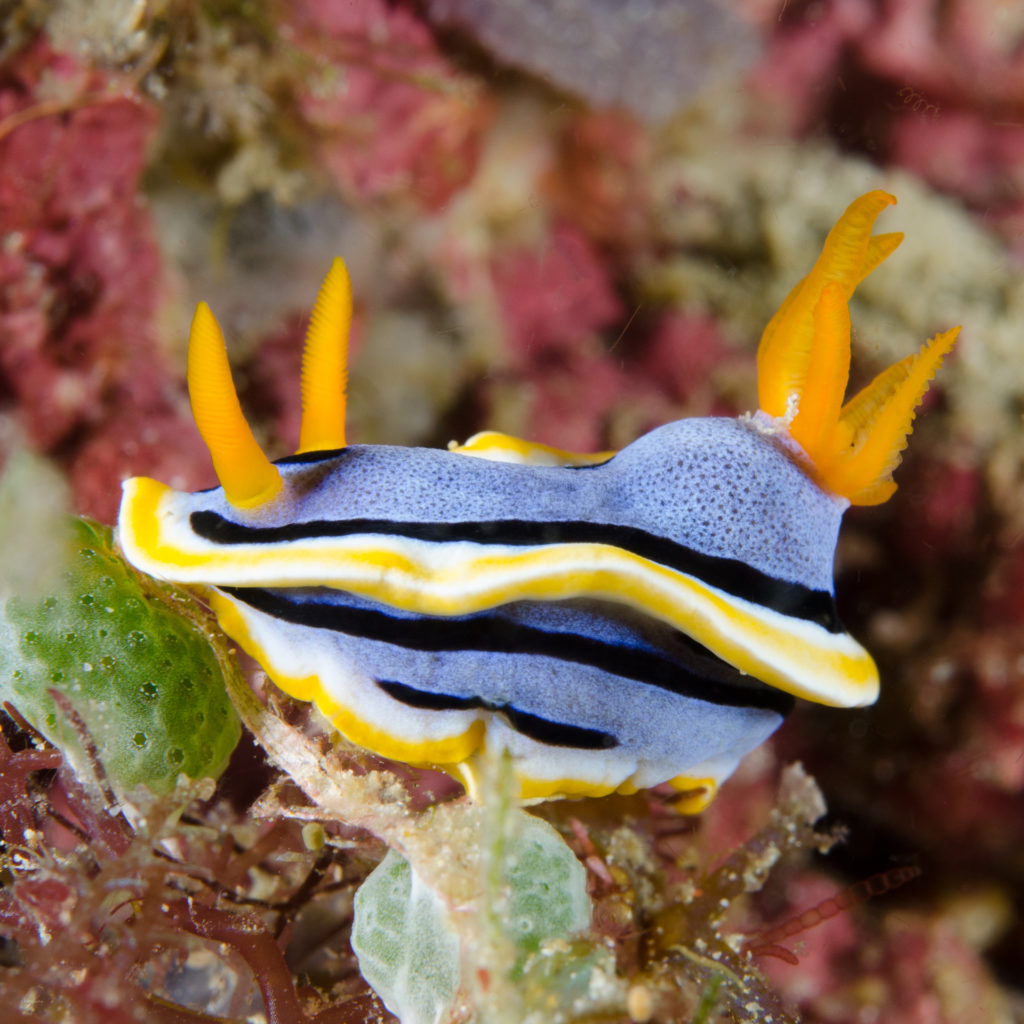
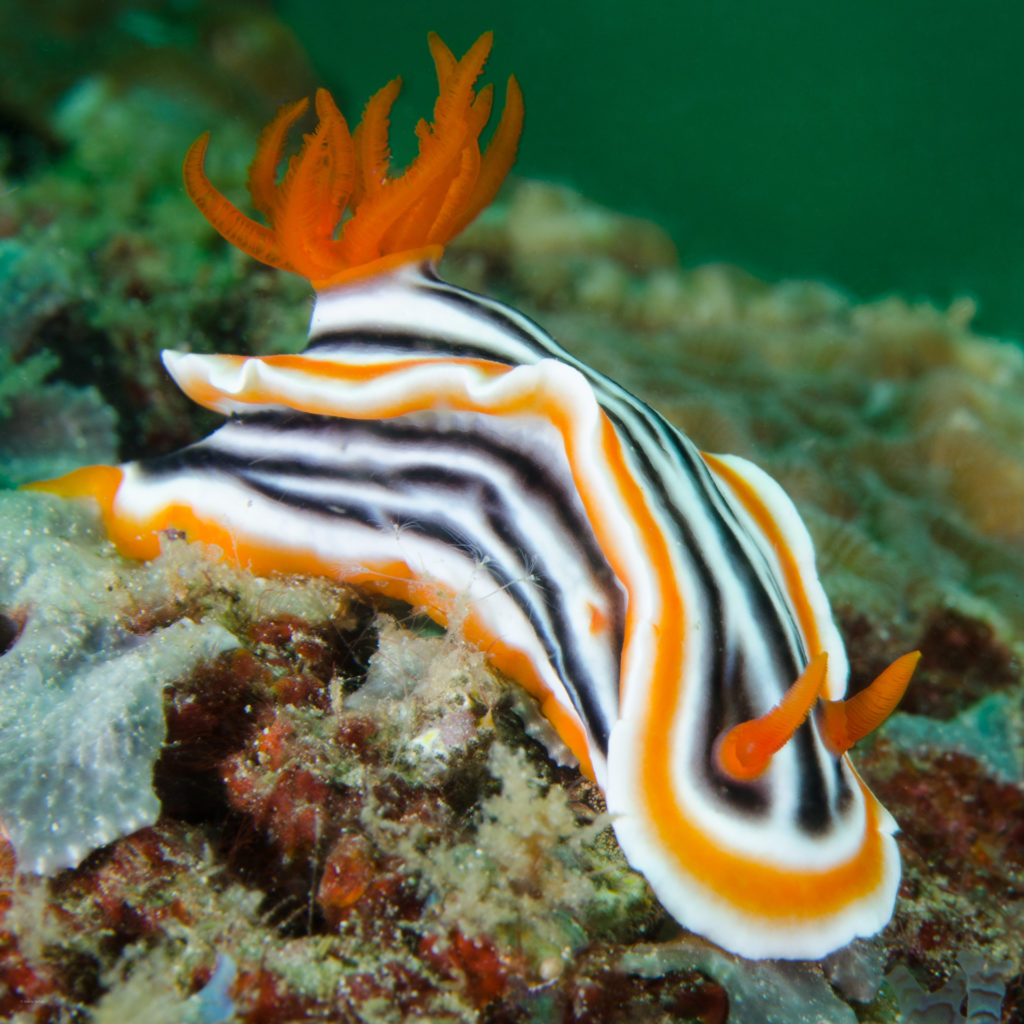
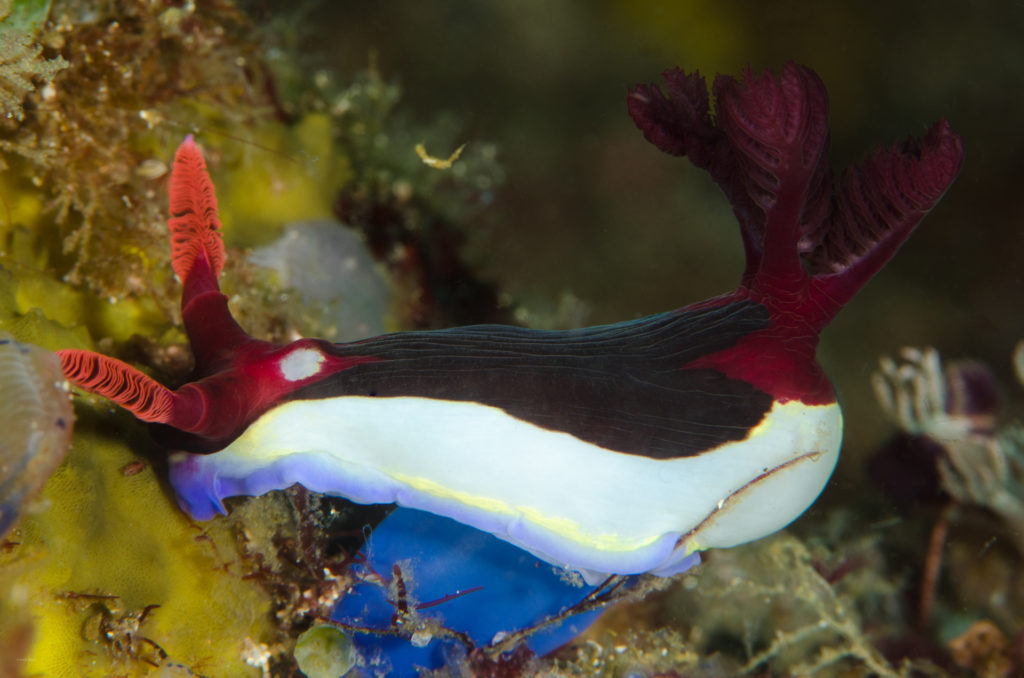
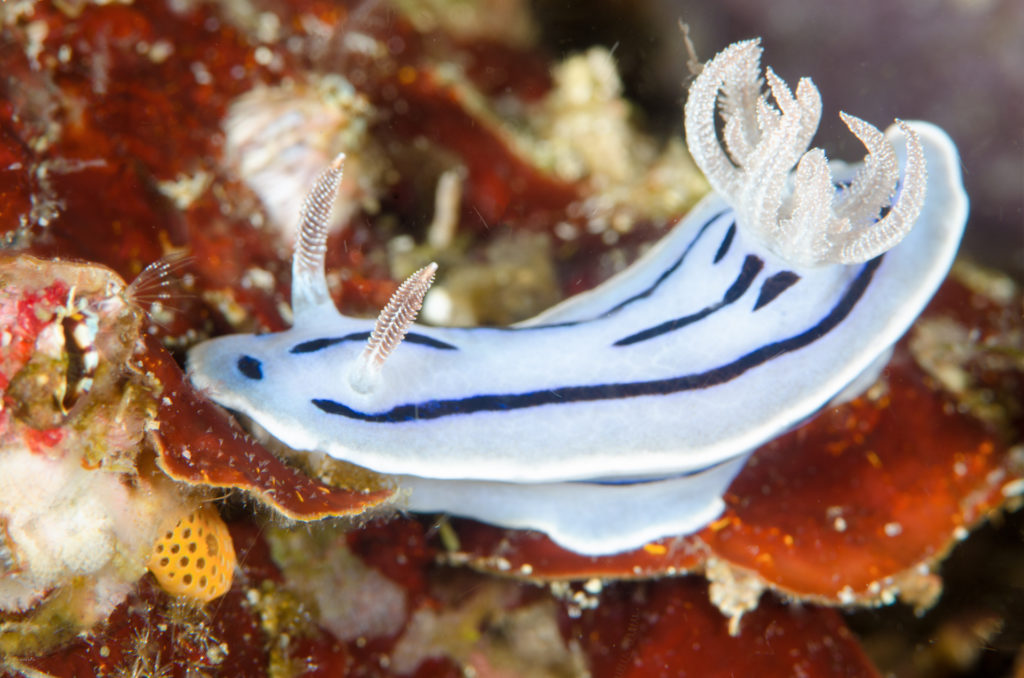
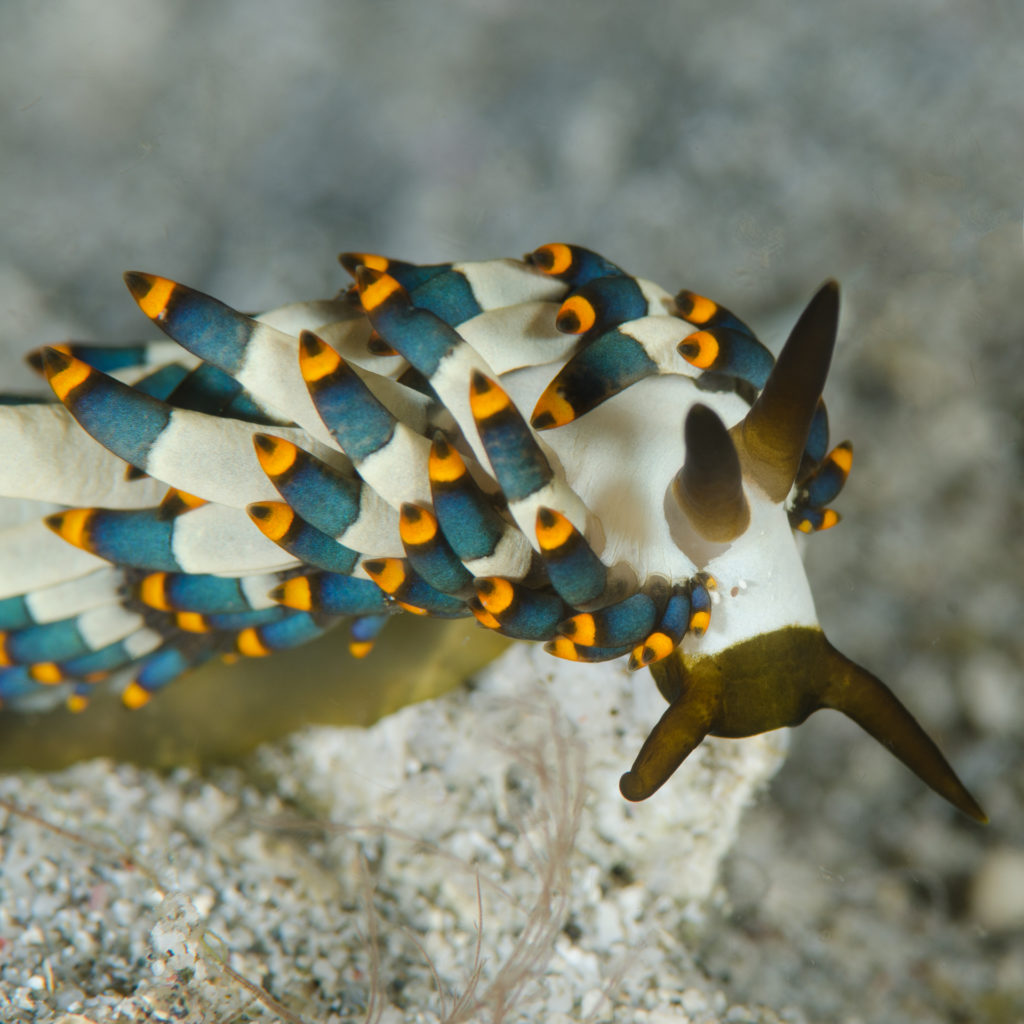
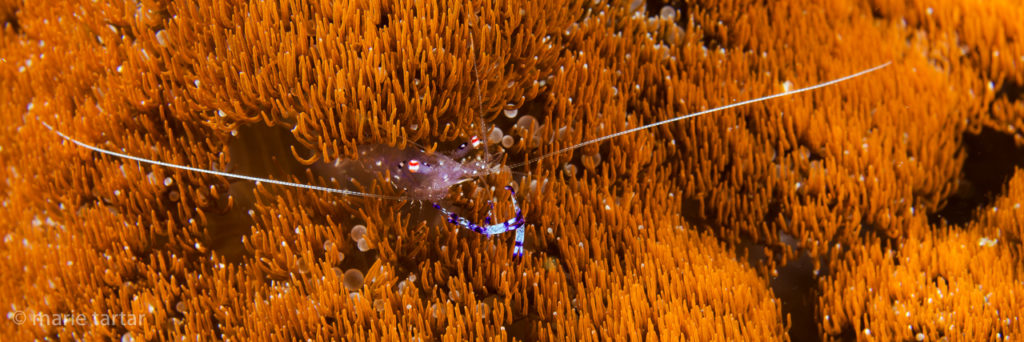
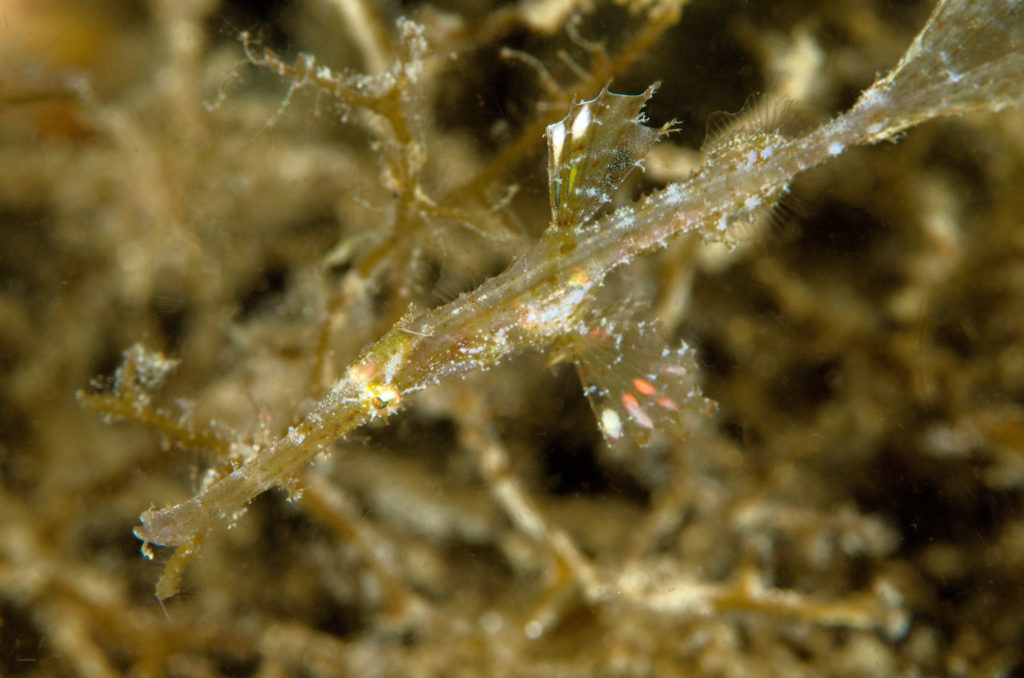
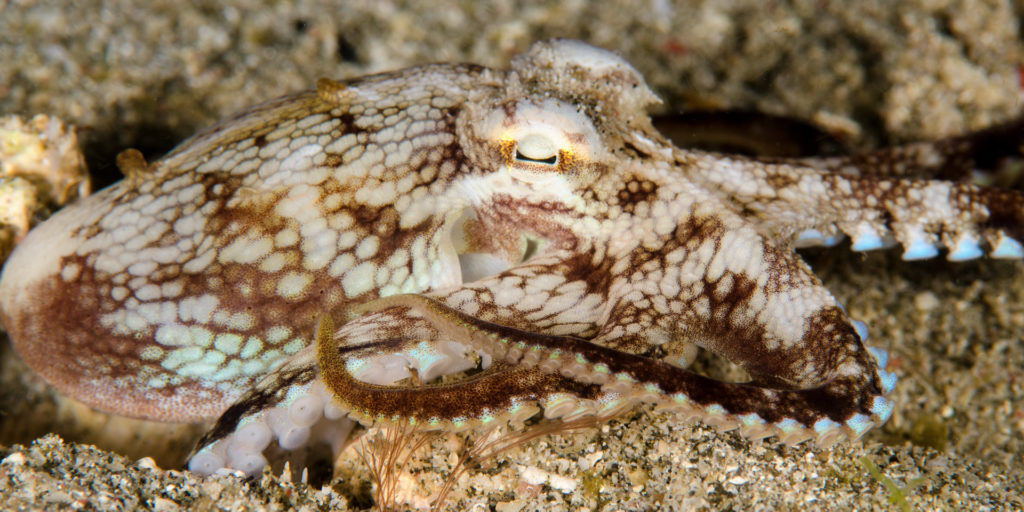



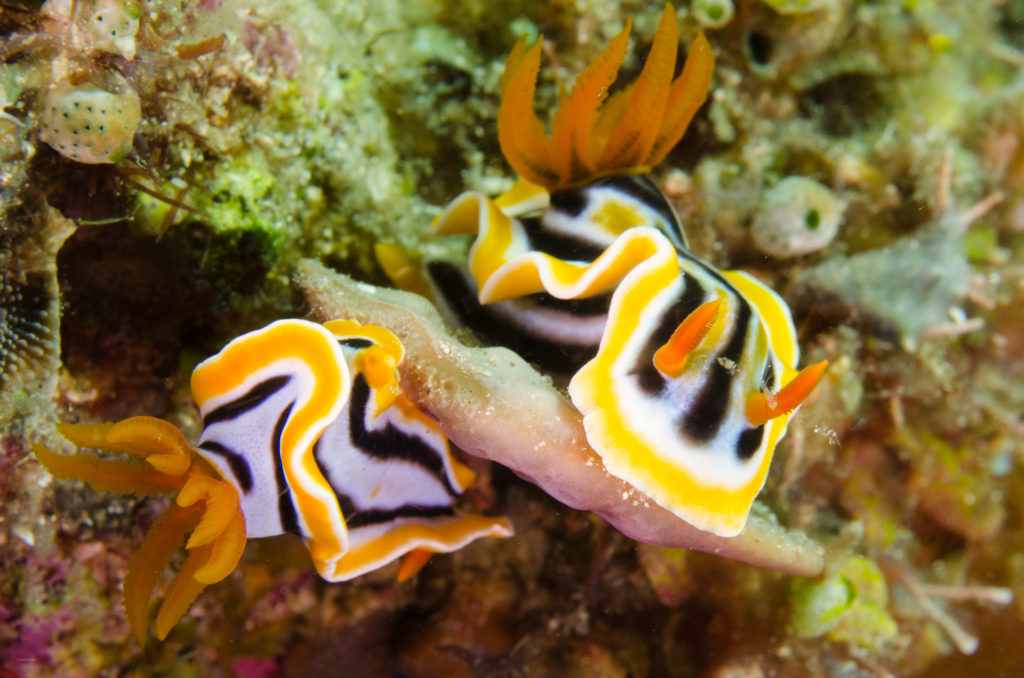
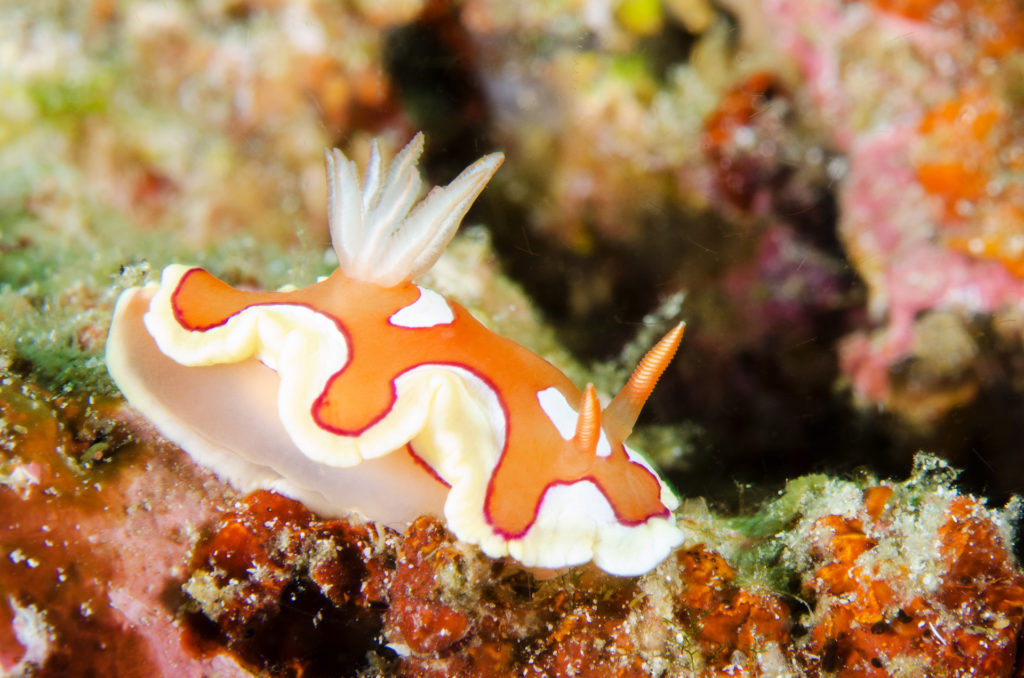

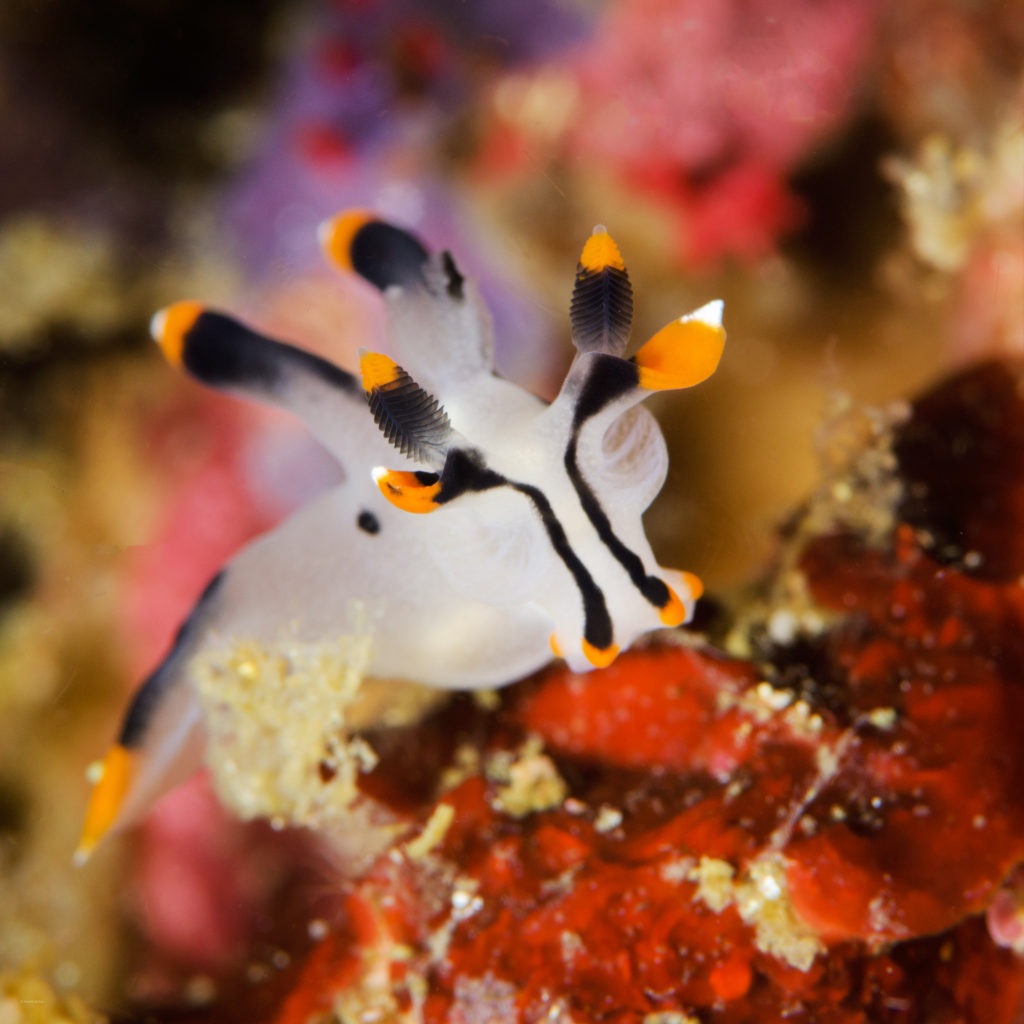
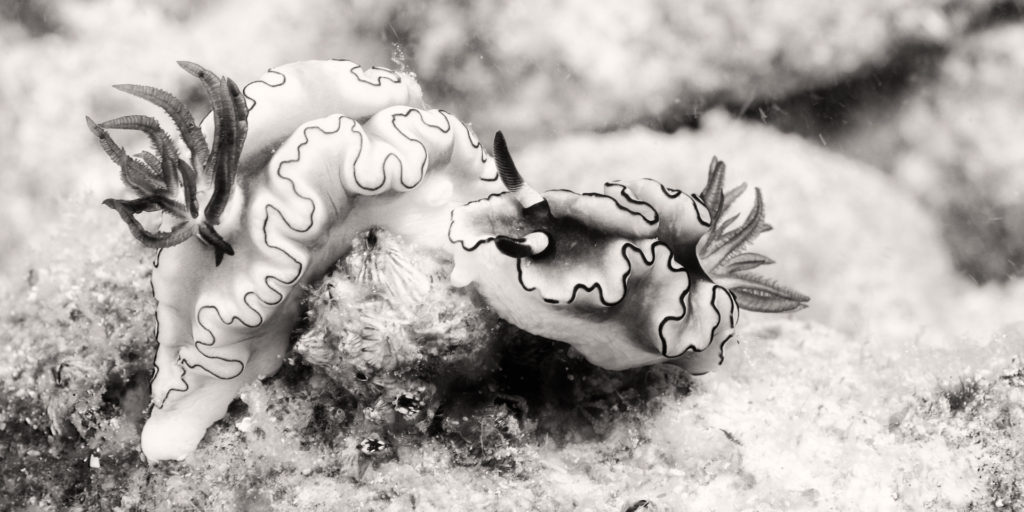
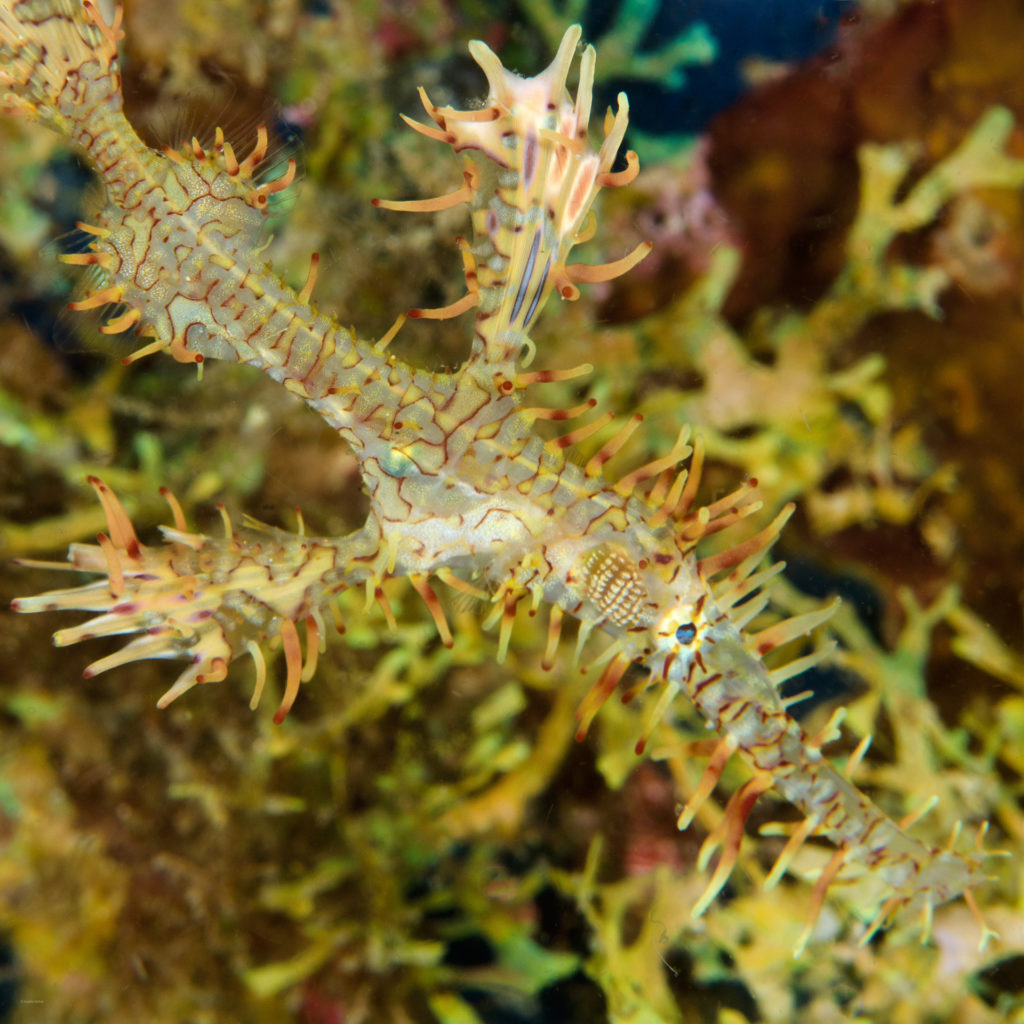
Thank you for sharing your stories and photos. I really enjoyed them, and you reinforced that Phil and I need to dive in the Phillippines.
Thanks for checking it out, Cameron. Hope to dive with you and Phil again, in Philippines or elsewhere!
-Marie